Distribution of Labour in Amazon Warehouse
VerifiedAdded on 2020/12/30
|38
|9198
|380
Project
AI Summary
This project examines the distribution of labor in Amazon warehouses, analyzing its impact on business performance and employee satisfaction. The study utilizes both primary and secondary research methods, including interviews with managers and a review of relevant literature. The findings highlight the importance of effective labor distribution for achieving organizational goals and provide recommendations for improvement.
Contribute Materials
Your contribution can guide someone’s learning journey. Share your
documents today.
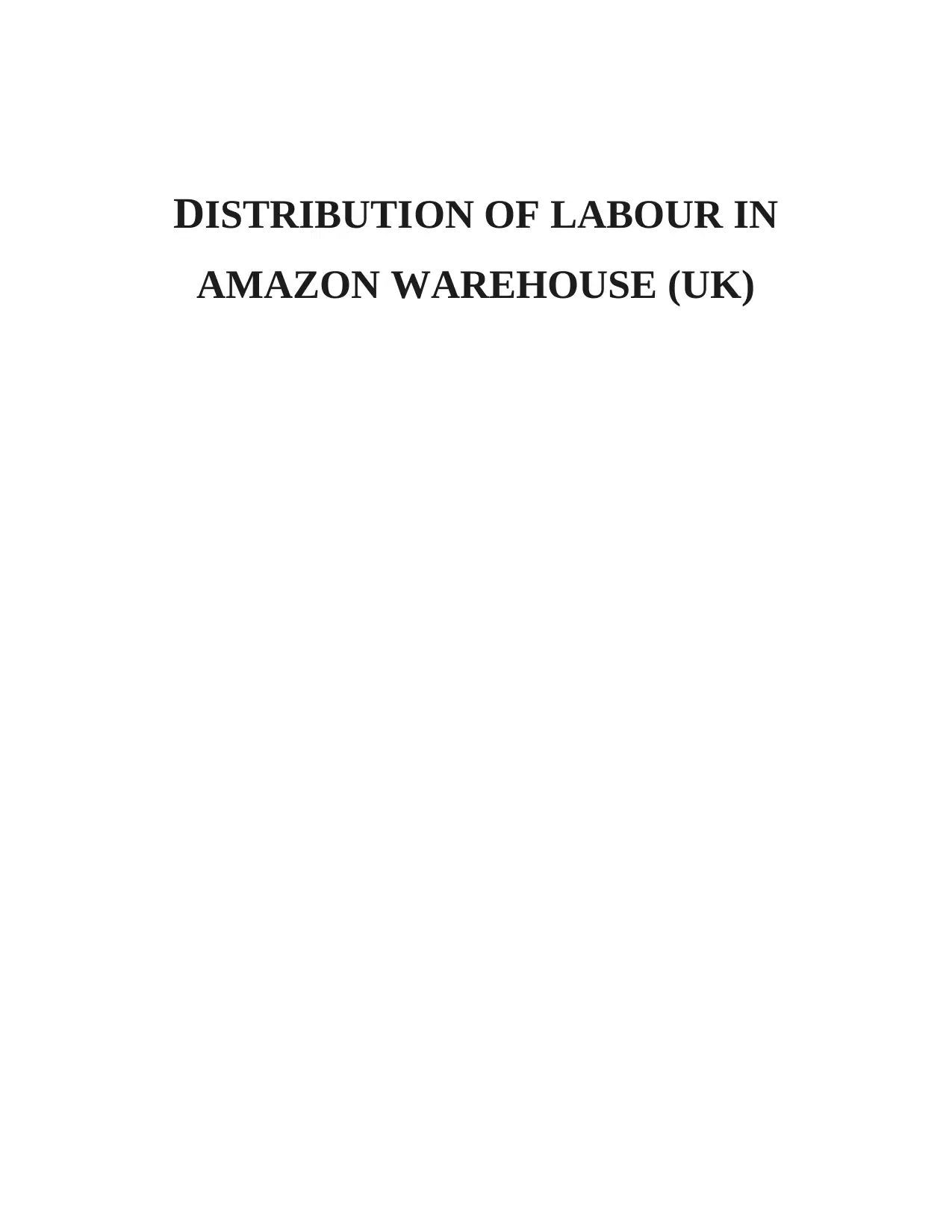
DISTRIBUTION OF LABOUR IN
AMAZON WAREHOUSE (UK)
AMAZON WAREHOUSE (UK)
Secure Best Marks with AI Grader
Need help grading? Try our AI Grader for instant feedback on your assignments.
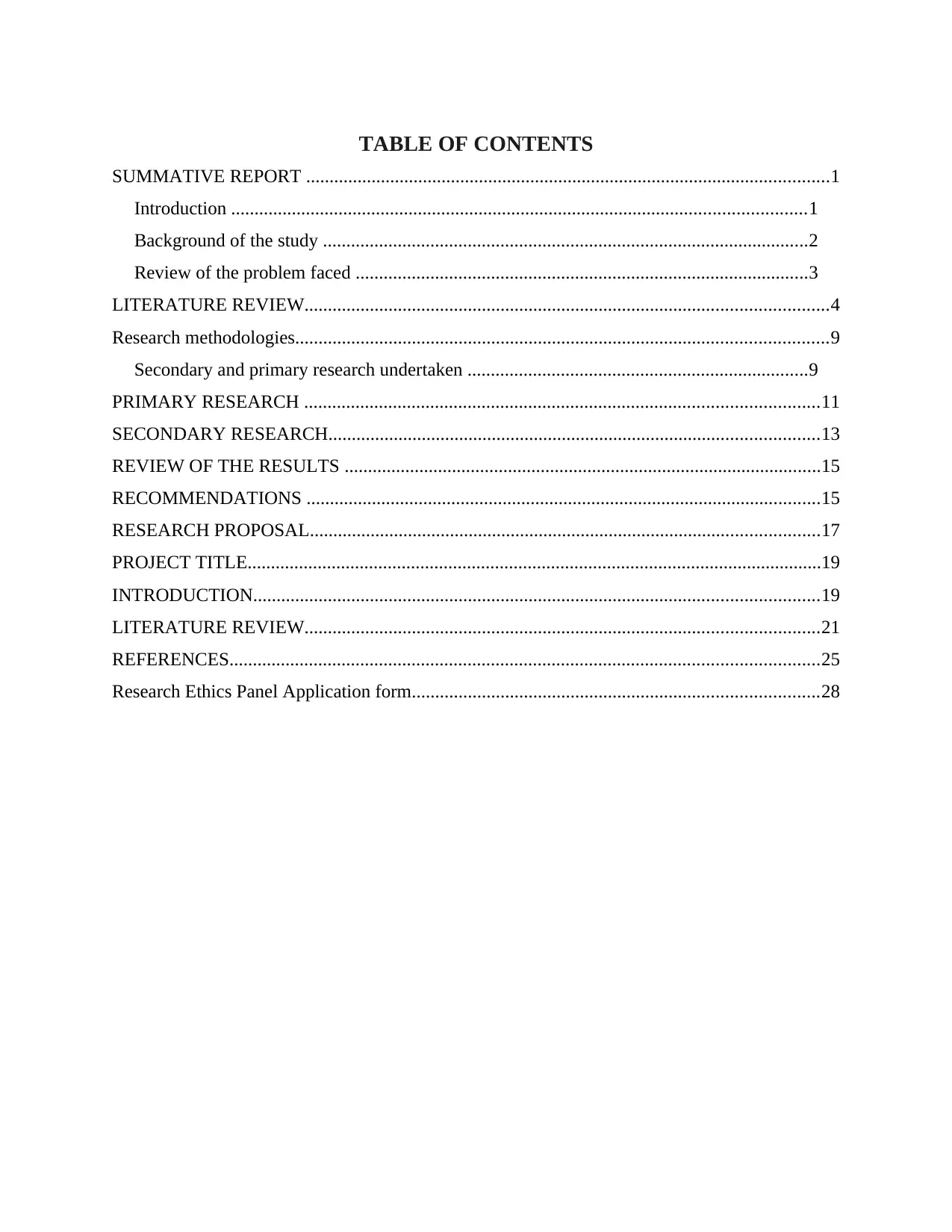
TABLE OF CONTENTS
SUMMATIVE REPORT ................................................................................................................1
Introduction ...........................................................................................................................1
Background of the study ........................................................................................................2
Review of the problem faced .................................................................................................3
LITERATURE REVIEW................................................................................................................4
Research methodologies..................................................................................................................9
Secondary and primary research undertaken .........................................................................9
PRIMARY RESEARCH ..............................................................................................................11
SECONDARY RESEARCH.........................................................................................................13
REVIEW OF THE RESULTS ......................................................................................................15
RECOMMENDATIONS ..............................................................................................................15
RESEARCH PROPOSAL.............................................................................................................17
PROJECT TITLE...........................................................................................................................19
INTRODUCTION.........................................................................................................................19
LITERATURE REVIEW..............................................................................................................21
REFERENCES..............................................................................................................................25
Research Ethics Panel Application form.......................................................................................28
SUMMATIVE REPORT ................................................................................................................1
Introduction ...........................................................................................................................1
Background of the study ........................................................................................................2
Review of the problem faced .................................................................................................3
LITERATURE REVIEW................................................................................................................4
Research methodologies..................................................................................................................9
Secondary and primary research undertaken .........................................................................9
PRIMARY RESEARCH ..............................................................................................................11
SECONDARY RESEARCH.........................................................................................................13
REVIEW OF THE RESULTS ......................................................................................................15
RECOMMENDATIONS ..............................................................................................................15
RESEARCH PROPOSAL.............................................................................................................17
PROJECT TITLE...........................................................................................................................19
INTRODUCTION.........................................................................................................................19
LITERATURE REVIEW..............................................................................................................21
REFERENCES..............................................................................................................................25
Research Ethics Panel Application form.......................................................................................28
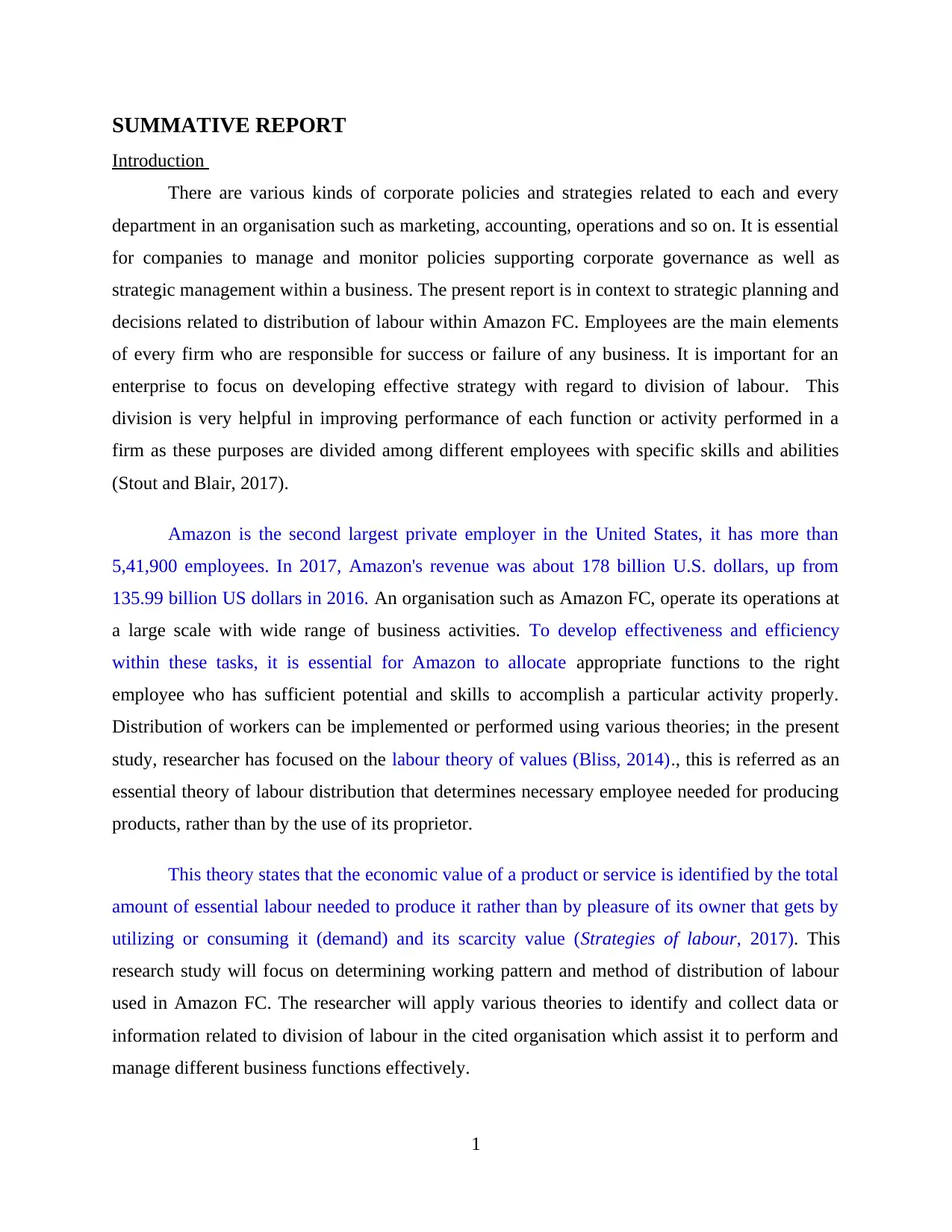
SUMMATIVE REPORT
Introduction
There are various kinds of corporate policies and strategies related to each and every
department in an organisation such as marketing, accounting, operations and so on. It is essential
for companies to manage and monitor policies supporting corporate governance as well as
strategic management within a business. The present report is in context to strategic planning and
decisions related to distribution of labour within Amazon FC. Employees are the main elements
of every firm who are responsible for success or failure of any business. It is important for an
enterprise to focus on developing effective strategy with regard to division of labour. This
division is very helpful in improving performance of each function or activity performed in a
firm as these purposes are divided among different employees with specific skills and abilities
(Stout and Blair, 2017).
Amazon is the second largest private employer in the United States, it has more than
5,41,900 employees. In 2017, Amazon's revenue was about 178 billion U.S. dollars, up from
135.99 billion US dollars in 2016. An organisation such as Amazon FC, operate its operations at
a large scale with wide range of business activities. To develop effectiveness and efficiency
within these tasks, it is essential for Amazon to allocate appropriate functions to the right
employee who has sufficient potential and skills to accomplish a particular activity properly.
Distribution of workers can be implemented or performed using various theories; in the present
study, researcher has focused on the labour theory of values (Bliss, 2014)., this is referred as an
essential theory of labour distribution that determines necessary employee needed for producing
products, rather than by the use of its proprietor.
This theory states that the economic value of a product or service is identified by the total
amount of essential labour needed to produce it rather than by pleasure of its owner that gets by
utilizing or consuming it (demand) and its scarcity value (Strategies of labour, 2017). This
research study will focus on determining working pattern and method of distribution of labour
used in Amazon FC. The researcher will apply various theories to identify and collect data or
information related to division of labour in the cited organisation which assist it to perform and
manage different business functions effectively.
1
Introduction
There are various kinds of corporate policies and strategies related to each and every
department in an organisation such as marketing, accounting, operations and so on. It is essential
for companies to manage and monitor policies supporting corporate governance as well as
strategic management within a business. The present report is in context to strategic planning and
decisions related to distribution of labour within Amazon FC. Employees are the main elements
of every firm who are responsible for success or failure of any business. It is important for an
enterprise to focus on developing effective strategy with regard to division of labour. This
division is very helpful in improving performance of each function or activity performed in a
firm as these purposes are divided among different employees with specific skills and abilities
(Stout and Blair, 2017).
Amazon is the second largest private employer in the United States, it has more than
5,41,900 employees. In 2017, Amazon's revenue was about 178 billion U.S. dollars, up from
135.99 billion US dollars in 2016. An organisation such as Amazon FC, operate its operations at
a large scale with wide range of business activities. To develop effectiveness and efficiency
within these tasks, it is essential for Amazon to allocate appropriate functions to the right
employee who has sufficient potential and skills to accomplish a particular activity properly.
Distribution of workers can be implemented or performed using various theories; in the present
study, researcher has focused on the labour theory of values (Bliss, 2014)., this is referred as an
essential theory of labour distribution that determines necessary employee needed for producing
products, rather than by the use of its proprietor.
This theory states that the economic value of a product or service is identified by the total
amount of essential labour needed to produce it rather than by pleasure of its owner that gets by
utilizing or consuming it (demand) and its scarcity value (Strategies of labour, 2017). This
research study will focus on determining working pattern and method of distribution of labour
used in Amazon FC. The researcher will apply various theories to identify and collect data or
information related to division of labour in the cited organisation which assist it to perform and
manage different business functions effectively.
1
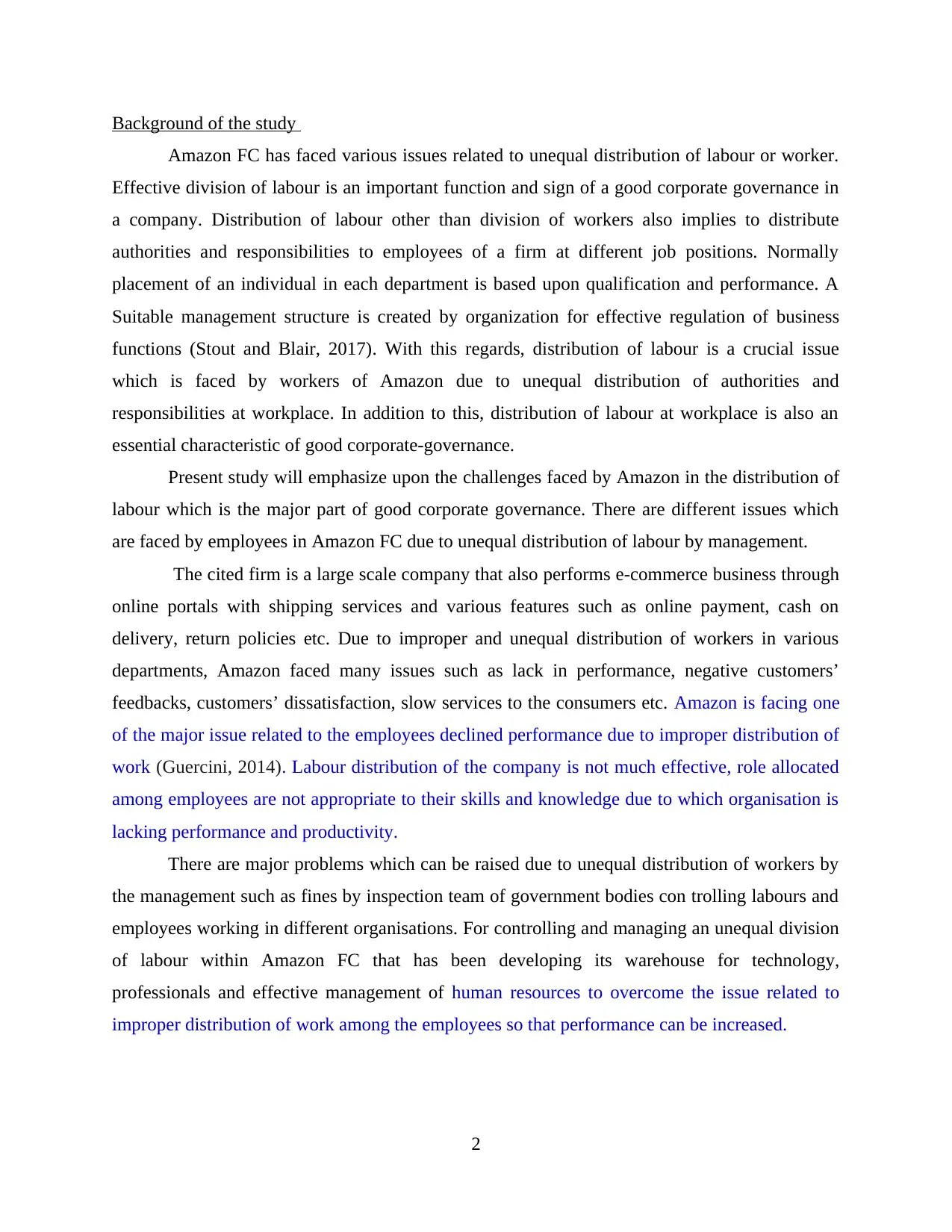
Background of the study
Amazon FC has faced various issues related to unequal distribution of labour or worker.
Effective division of labour is an important function and sign of a good corporate governance in
a company. Distribution of labour other than division of workers also implies to distribute
authorities and responsibilities to employees of a firm at different job positions. Normally
placement of an individual in each department is based upon qualification and performance. A
Suitable management structure is created by organization for effective regulation of business
functions (Stout and Blair, 2017). With this regards, distribution of labour is a crucial issue
which is faced by workers of Amazon due to unequal distribution of authorities and
responsibilities at workplace. In addition to this, distribution of labour at workplace is also an
essential characteristic of good corporate-governance.
Present study will emphasize upon the challenges faced by Amazon in the distribution of
labour which is the major part of good corporate governance. There are different issues which
are faced by employees in Amazon FC due to unequal distribution of labour by management.
The cited firm is a large scale company that also performs e-commerce business through
online portals with shipping services and various features such as online payment, cash on
delivery, return policies etc. Due to improper and unequal distribution of workers in various
departments, Amazon faced many issues such as lack in performance, negative customers’
feedbacks, customers’ dissatisfaction, slow services to the consumers etc. Amazon is facing one
of the major issue related to the employees declined performance due to improper distribution of
work (Guercini, 2014). Labour distribution of the company is not much effective, role allocated
among employees are not appropriate to their skills and knowledge due to which organisation is
lacking performance and productivity.
There are major problems which can be raised due to unequal distribution of workers by
the management such as fines by inspection team of government bodies con trolling labours and
employees working in different organisations. For controlling and managing an unequal division
of labour within Amazon FC that has been developing its warehouse for technology,
professionals and effective management of human resources to overcome the issue related to
improper distribution of work among the employees so that performance can be increased.
2
Amazon FC has faced various issues related to unequal distribution of labour or worker.
Effective division of labour is an important function and sign of a good corporate governance in
a company. Distribution of labour other than division of workers also implies to distribute
authorities and responsibilities to employees of a firm at different job positions. Normally
placement of an individual in each department is based upon qualification and performance. A
Suitable management structure is created by organization for effective regulation of business
functions (Stout and Blair, 2017). With this regards, distribution of labour is a crucial issue
which is faced by workers of Amazon due to unequal distribution of authorities and
responsibilities at workplace. In addition to this, distribution of labour at workplace is also an
essential characteristic of good corporate-governance.
Present study will emphasize upon the challenges faced by Amazon in the distribution of
labour which is the major part of good corporate governance. There are different issues which
are faced by employees in Amazon FC due to unequal distribution of labour by management.
The cited firm is a large scale company that also performs e-commerce business through
online portals with shipping services and various features such as online payment, cash on
delivery, return policies etc. Due to improper and unequal distribution of workers in various
departments, Amazon faced many issues such as lack in performance, negative customers’
feedbacks, customers’ dissatisfaction, slow services to the consumers etc. Amazon is facing one
of the major issue related to the employees declined performance due to improper distribution of
work (Guercini, 2014). Labour distribution of the company is not much effective, role allocated
among employees are not appropriate to their skills and knowledge due to which organisation is
lacking performance and productivity.
There are major problems which can be raised due to unequal distribution of workers by
the management such as fines by inspection team of government bodies con trolling labours and
employees working in different organisations. For controlling and managing an unequal division
of labour within Amazon FC that has been developing its warehouse for technology,
professionals and effective management of human resources to overcome the issue related to
improper distribution of work among the employees so that performance can be increased.
2
Secure Best Marks with AI Grader
Need help grading? Try our AI Grader for instant feedback on your assignments.

Review of the problem faced
Primary issue observed in Amazon is improper distribution of work among employees,
due to ineffective allocation roles and responsibilities to the labours organisation is lacking
performance & productivity (Guercini, 2014). To complete this research, I faced several issues
such as collection of data, choosing the research methodologies and measuring the reliability of
the outcomes generated through this examination. The topic selected for this study was complex
and needed a deep understanding. Distribution of labour is an essential function or approach
which is utilised by each and every organisation which makes it an interesting topic to study on.
There is a huge information related to division of labour available on internet and other sources
such as books, articles and journals. Therefore, for collecting the most appropriate data related to
employees’ distribution was a difficult task for me which affected my choice of research
methods such as data collection, research approach, design of the study etc. However, I chose
this topic after appropriate research that determined the entire wide scope of study.
Further, this project will give support in creating qualitative analysis, reasoning,
comprehending, technical and understanding skills. It will also give in understanding about
various methods used by corporate governance and strategies. The research examination will
focus on identifying various methods of distribution used by Amazon FC to distribute workers
within various departments or functions.
3
Primary issue observed in Amazon is improper distribution of work among employees,
due to ineffective allocation roles and responsibilities to the labours organisation is lacking
performance & productivity (Guercini, 2014). To complete this research, I faced several issues
such as collection of data, choosing the research methodologies and measuring the reliability of
the outcomes generated through this examination. The topic selected for this study was complex
and needed a deep understanding. Distribution of labour is an essential function or approach
which is utilised by each and every organisation which makes it an interesting topic to study on.
There is a huge information related to division of labour available on internet and other sources
such as books, articles and journals. Therefore, for collecting the most appropriate data related to
employees’ distribution was a difficult task for me which affected my choice of research
methods such as data collection, research approach, design of the study etc. However, I chose
this topic after appropriate research that determined the entire wide scope of study.
Further, this project will give support in creating qualitative analysis, reasoning,
comprehending, technical and understanding skills. It will also give in understanding about
various methods used by corporate governance and strategies. The research examination will
focus on identifying various methods of distribution used by Amazon FC to distribute workers
within various departments or functions.
3
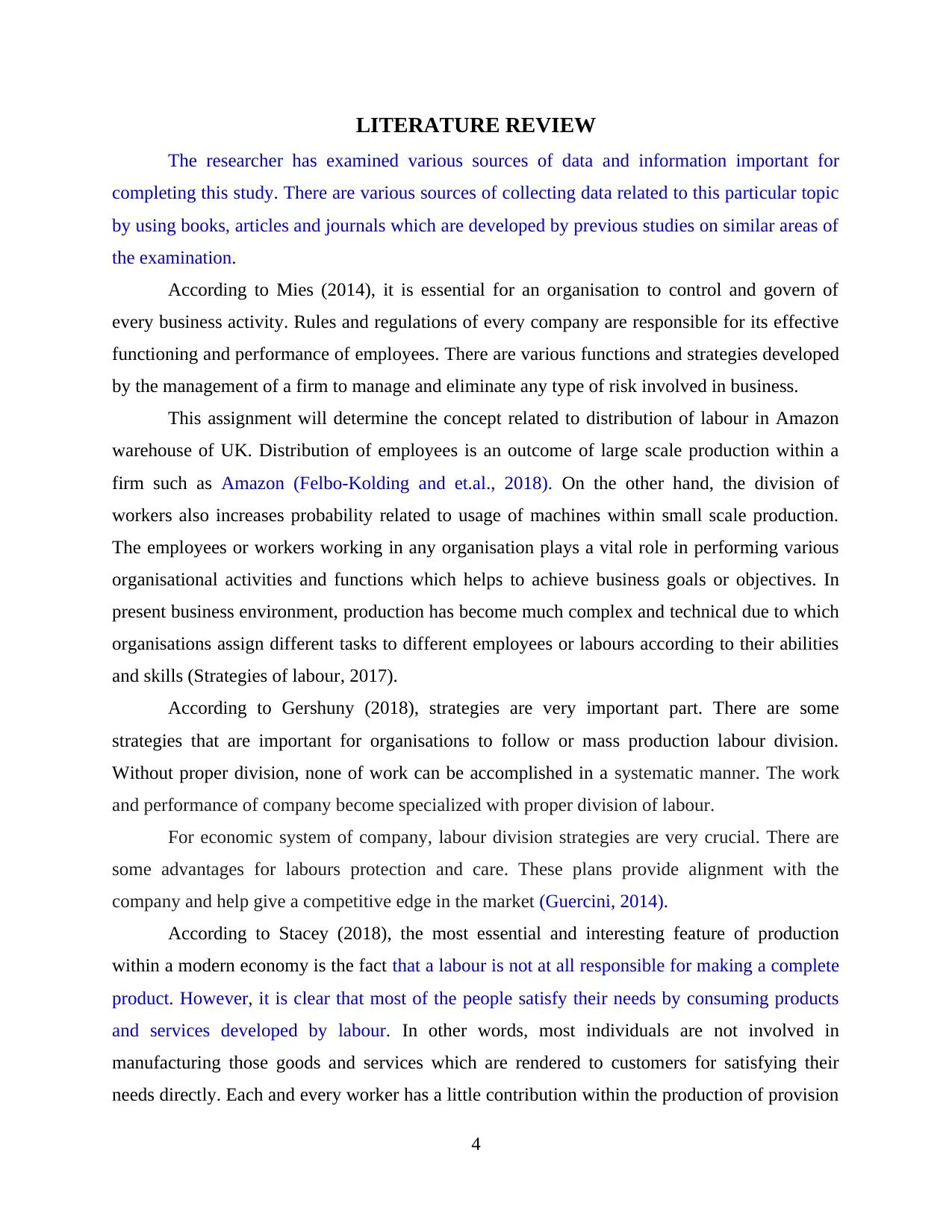
LITERATURE REVIEW
The researcher has examined various sources of data and information important for
completing this study. There are various sources of collecting data related to this particular topic
by using books, articles and journals which are developed by previous studies on similar areas of
the examination.
According to Mies (2014), it is essential for an organisation to control and govern of
every business activity. Rules and regulations of every company are responsible for its effective
functioning and performance of employees. There are various functions and strategies developed
by the management of a firm to manage and eliminate any type of risk involved in business.
This assignment will determine the concept related to distribution of labour in Amazon
warehouse of UK. Distribution of employees is an outcome of large scale production within a
firm such as Amazon (Felbo-Kolding and et.al., 2018). On the other hand, the division of
workers also increases probability related to usage of machines within small scale production.
The employees or workers working in any organisation plays a vital role in performing various
organisational activities and functions which helps to achieve business goals or objectives. In
present business environment, production has become much complex and technical due to which
organisations assign different tasks to different employees or labours according to their abilities
and skills (Strategies of labour, 2017).
According to Gershuny (2018), strategies are very important part. There are some
strategies that are important for organisations to follow or mass production labour division.
Without proper division, none of work can be accomplished in a systematic manner. The work
and performance of company become specialized with proper division of labour.
For economic system of company, labour division strategies are very crucial. There are
some advantages for labours protection and care. These plans provide alignment with the
company and help give a competitive edge in the market (Guercini, 2014).
According to Stacey (2018), the most essential and interesting feature of production
within a modern economy is the fact that a labour is not at all responsible for making a complete
product. However, it is clear that most of the people satisfy their needs by consuming products
and services developed by labour. In other words, most individuals are not involved in
manufacturing those goods and services which are rendered to customers for satisfying their
needs directly. Each and every worker has a little contribution within the production of provision
4
The researcher has examined various sources of data and information important for
completing this study. There are various sources of collecting data related to this particular topic
by using books, articles and journals which are developed by previous studies on similar areas of
the examination.
According to Mies (2014), it is essential for an organisation to control and govern of
every business activity. Rules and regulations of every company are responsible for its effective
functioning and performance of employees. There are various functions and strategies developed
by the management of a firm to manage and eliminate any type of risk involved in business.
This assignment will determine the concept related to distribution of labour in Amazon
warehouse of UK. Distribution of employees is an outcome of large scale production within a
firm such as Amazon (Felbo-Kolding and et.al., 2018). On the other hand, the division of
workers also increases probability related to usage of machines within small scale production.
The employees or workers working in any organisation plays a vital role in performing various
organisational activities and functions which helps to achieve business goals or objectives. In
present business environment, production has become much complex and technical due to which
organisations assign different tasks to different employees or labours according to their abilities
and skills (Strategies of labour, 2017).
According to Gershuny (2018), strategies are very important part. There are some
strategies that are important for organisations to follow or mass production labour division.
Without proper division, none of work can be accomplished in a systematic manner. The work
and performance of company become specialized with proper division of labour.
For economic system of company, labour division strategies are very crucial. There are
some advantages for labours protection and care. These plans provide alignment with the
company and help give a competitive edge in the market (Guercini, 2014).
According to Stacey (2018), the most essential and interesting feature of production
within a modern economy is the fact that a labour is not at all responsible for making a complete
product. However, it is clear that most of the people satisfy their needs by consuming products
and services developed by labour. In other words, most individuals are not involved in
manufacturing those goods and services which are rendered to customers for satisfying their
needs directly. Each and every worker has a little contribution within the production of provision
4
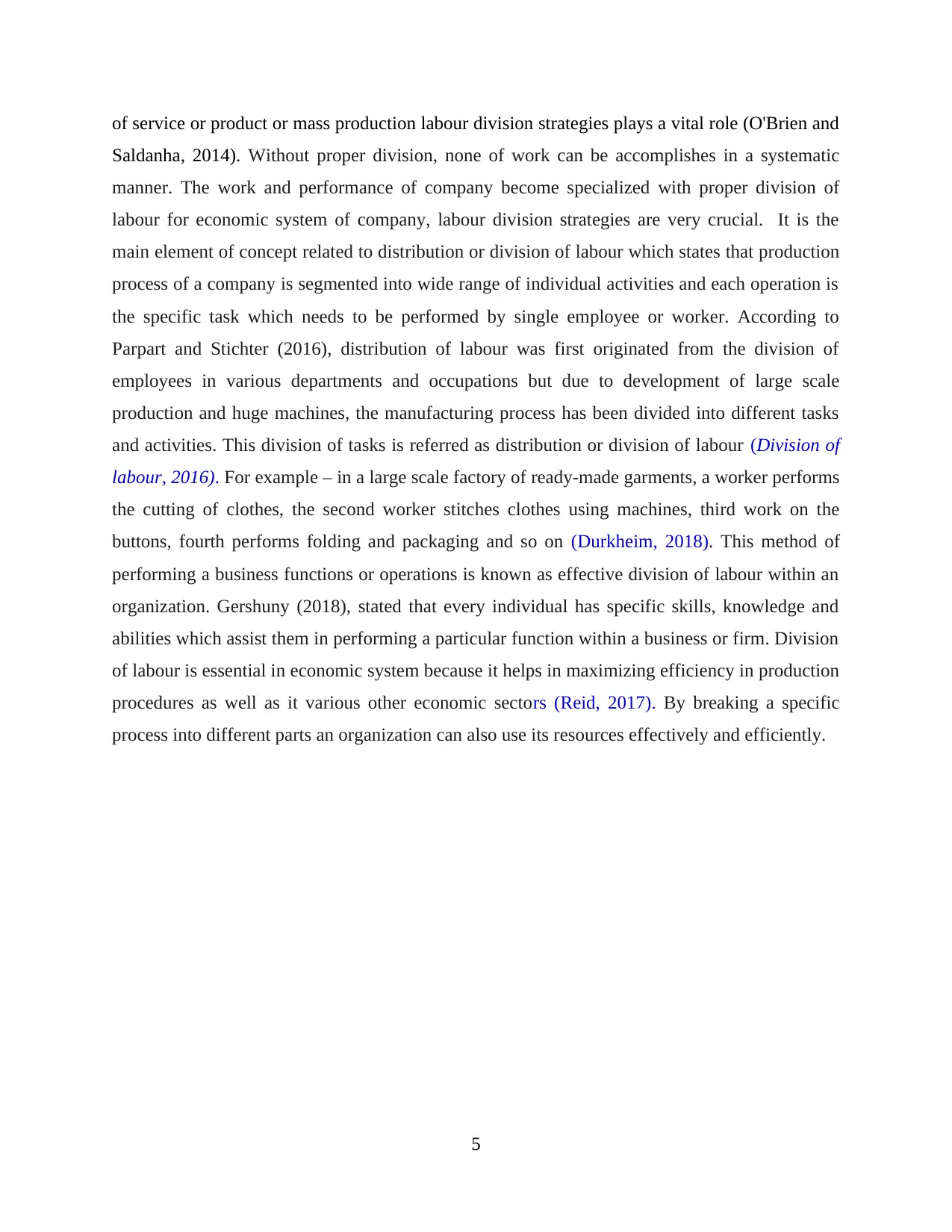
of service or product or mass production labour division strategies plays a vital role (O'Brien and
Saldanha, 2014). Without proper division, none of work can be accomplishes in a systematic
manner. The work and performance of company become specialized with proper division of
labour for economic system of company, labour division strategies are very crucial. It is the
main element of concept related to distribution or division of labour which states that production
process of a company is segmented into wide range of individual activities and each operation is
the specific task which needs to be performed by single employee or worker. According to
Parpart and Stichter (2016), distribution of labour was first originated from the division of
employees in various departments and occupations but due to development of large scale
production and huge machines, the manufacturing process has been divided into different tasks
and activities. This division of tasks is referred as distribution or division of labour (Division of
labour, 2016). For example – in a large scale factory of ready-made garments, a worker performs
the cutting of clothes, the second worker stitches clothes using machines, third work on the
buttons, fourth performs folding and packaging and so on (Durkheim, 2018). This method of
performing a business functions or operations is known as effective division of labour within an
organization. Gershuny (2018), stated that every individual has specific skills, knowledge and
abilities which assist them in performing a particular function within a business or firm. Division
of labour is essential in economic system because it helps in maximizing efficiency in production
procedures as well as it various other economic sectors (Reid, 2017). By breaking a specific
process into different parts an organization can also use its resources effectively and efficiently.
5
Saldanha, 2014). Without proper division, none of work can be accomplishes in a systematic
manner. The work and performance of company become specialized with proper division of
labour for economic system of company, labour division strategies are very crucial. It is the
main element of concept related to distribution or division of labour which states that production
process of a company is segmented into wide range of individual activities and each operation is
the specific task which needs to be performed by single employee or worker. According to
Parpart and Stichter (2016), distribution of labour was first originated from the division of
employees in various departments and occupations but due to development of large scale
production and huge machines, the manufacturing process has been divided into different tasks
and activities. This division of tasks is referred as distribution or division of labour (Division of
labour, 2016). For example – in a large scale factory of ready-made garments, a worker performs
the cutting of clothes, the second worker stitches clothes using machines, third work on the
buttons, fourth performs folding and packaging and so on (Durkheim, 2018). This method of
performing a business functions or operations is known as effective division of labour within an
organization. Gershuny (2018), stated that every individual has specific skills, knowledge and
abilities which assist them in performing a particular function within a business or firm. Division
of labour is essential in economic system because it helps in maximizing efficiency in production
procedures as well as it various other economic sectors (Reid, 2017). By breaking a specific
process into different parts an organization can also use its resources effectively and efficiently.
5
Paraphrase This Document
Need a fresh take? Get an instant paraphrase of this document with our AI Paraphraser
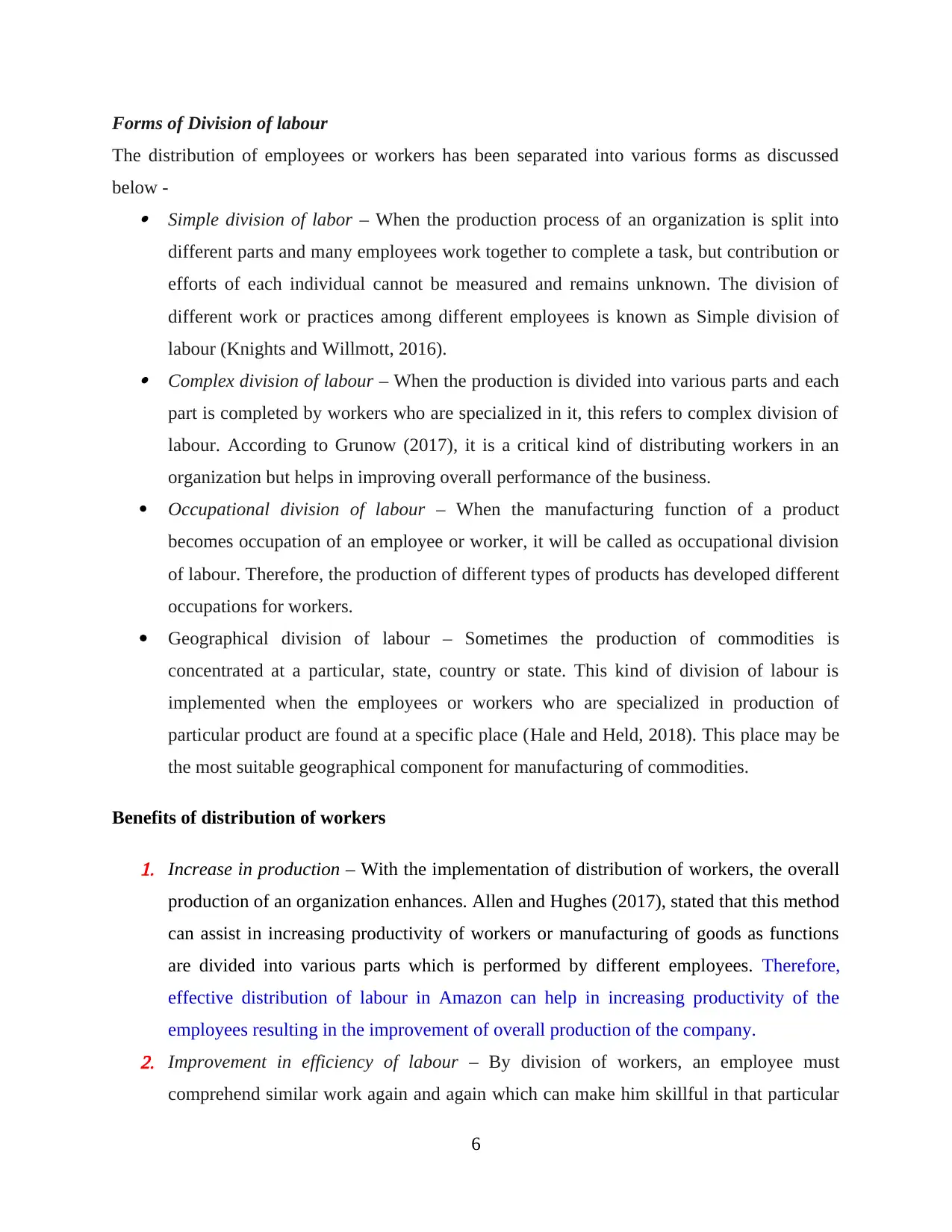
Forms of Division of labour
The distribution of employees or workers has been separated into various forms as discussed
below - Simple division of labor – When the production process of an organization is split into
different parts and many employees work together to complete a task, but contribution or
efforts of each individual cannot be measured and remains unknown. The division of
different work or practices among different employees is known as Simple division of
labour (Knights and Willmott, 2016). Complex division of labour – When the production is divided into various parts and each
part is completed by workers who are specialized in it, this refers to complex division of
labour. According to Grunow (2017), it is a critical kind of distributing workers in an
organization but helps in improving overall performance of the business.
Occupational division of labour – When the manufacturing function of a product
becomes occupation of an employee or worker, it will be called as occupational division
of labour. Therefore, the production of different types of products has developed different
occupations for workers.
Geographical division of labour – Sometimes the production of commodities is
concentrated at a particular, state, country or state. This kind of division of labour is
implemented when the employees or workers who are specialized in production of
particular product are found at a specific place (Hale and Held, 2018). This place may be
the most suitable geographical component for manufacturing of commodities.
Benefits of distribution of workers
1. Increase in production – With the implementation of distribution of workers, the overall
production of an organization enhances. Allen and Hughes (2017), stated that this method
can assist in increasing productivity of workers or manufacturing of goods as functions
are divided into various parts which is performed by different employees. Therefore,
effective distribution of labour in Amazon can help in increasing productivity of the
employees resulting in the improvement of overall production of the company.2. Improvement in efficiency of labour – By division of workers, an employee must
comprehend similar work again and again which can make him skillful in that particular
6
The distribution of employees or workers has been separated into various forms as discussed
below - Simple division of labor – When the production process of an organization is split into
different parts and many employees work together to complete a task, but contribution or
efforts of each individual cannot be measured and remains unknown. The division of
different work or practices among different employees is known as Simple division of
labour (Knights and Willmott, 2016). Complex division of labour – When the production is divided into various parts and each
part is completed by workers who are specialized in it, this refers to complex division of
labour. According to Grunow (2017), it is a critical kind of distributing workers in an
organization but helps in improving overall performance of the business.
Occupational division of labour – When the manufacturing function of a product
becomes occupation of an employee or worker, it will be called as occupational division
of labour. Therefore, the production of different types of products has developed different
occupations for workers.
Geographical division of labour – Sometimes the production of commodities is
concentrated at a particular, state, country or state. This kind of division of labour is
implemented when the employees or workers who are specialized in production of
particular product are found at a specific place (Hale and Held, 2018). This place may be
the most suitable geographical component for manufacturing of commodities.
Benefits of distribution of workers
1. Increase in production – With the implementation of distribution of workers, the overall
production of an organization enhances. Allen and Hughes (2017), stated that this method
can assist in increasing productivity of workers or manufacturing of goods as functions
are divided into various parts which is performed by different employees. Therefore,
effective distribution of labour in Amazon can help in increasing productivity of the
employees resulting in the improvement of overall production of the company.2. Improvement in efficiency of labour – By division of workers, an employee must
comprehend similar work again and again which can make him skillful in that particular
6
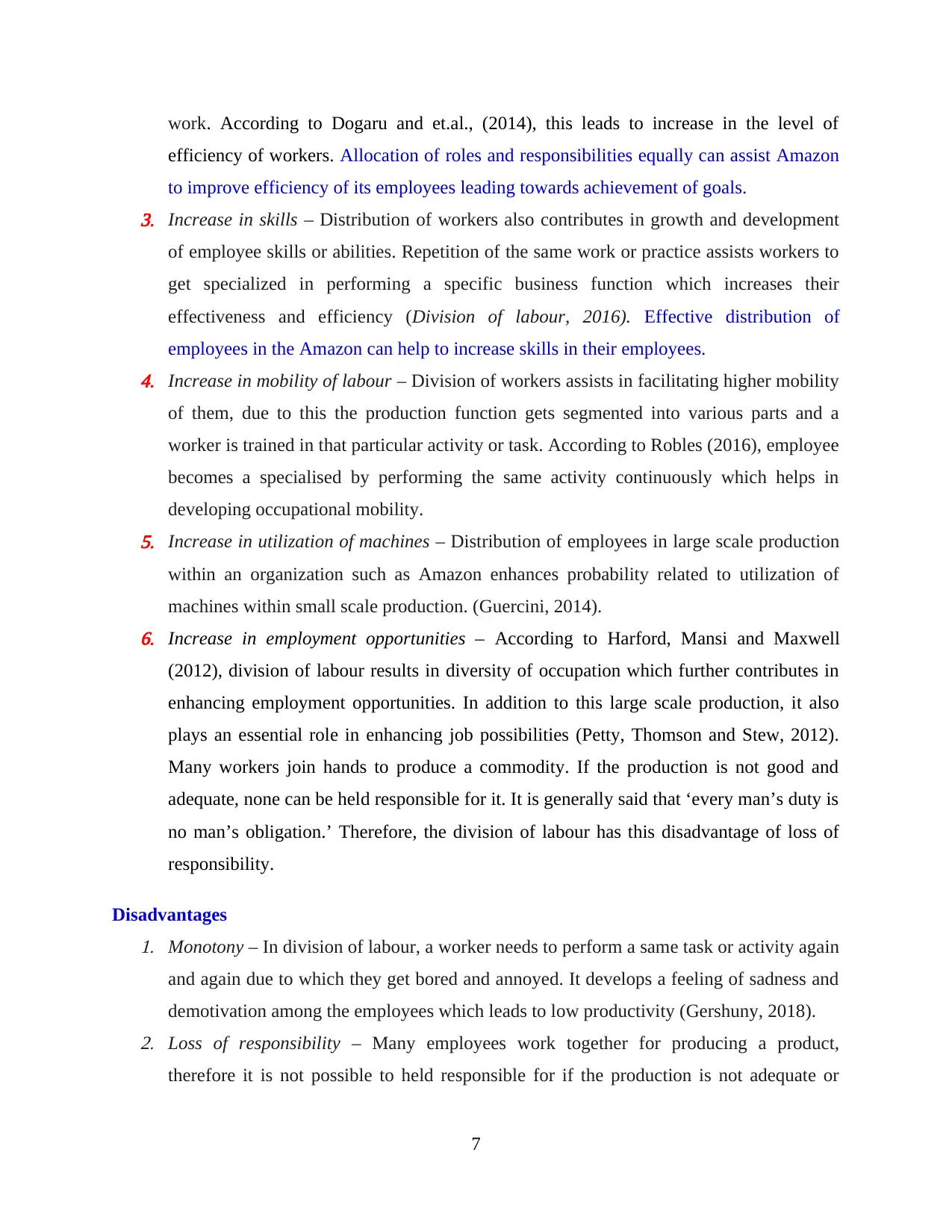
work. According to Dogaru and et.al., (2014), this leads to increase in the level of
efficiency of workers. Allocation of roles and responsibilities equally can assist Amazon
to improve efficiency of its employees leading towards achievement of goals.3. Increase in skills – Distribution of workers also contributes in growth and development
of employee skills or abilities. Repetition of the same work or practice assists workers to
get specialized in performing a specific business function which increases their
effectiveness and efficiency (Division of labour, 2016). Effective distribution of
employees in the Amazon can help to increase skills in their employees.4. Increase in mobility of labour – Division of workers assists in facilitating higher mobility
of them, due to this the production function gets segmented into various parts and a
worker is trained in that particular activity or task. According to Robles (2016), employee
becomes a specialised by performing the same activity continuously which helps in
developing occupational mobility.5. Increase in utilization of machines – Distribution of employees in large scale production
within an organization such as Amazon enhances probability related to utilization of
machines within small scale production. (Guercini, 2014).6. Increase in employment opportunities – According to Harford, Mansi and Maxwell
(2012), division of labour results in diversity of occupation which further contributes in
enhancing employment opportunities. In addition to this large scale production, it also
plays an essential role in enhancing job possibilities (Petty, Thomson and Stew, 2012).
Many workers join hands to produce a commodity. If the production is not good and
adequate, none can be held responsible for it. It is generally said that ‘every man’s duty is
no man’s obligation.’ Therefore, the division of labour has this disadvantage of loss of
responsibility.
Disadvantages1. Monotony – In division of labour, a worker needs to perform a same task or activity again
and again due to which they get bored and annoyed. It develops a feeling of sadness and
demotivation among the employees which leads to low productivity (Gershuny, 2018).2. Loss of responsibility – Many employees work together for producing a product,
therefore it is not possible to held responsible for if the production is not adequate or
7
efficiency of workers. Allocation of roles and responsibilities equally can assist Amazon
to improve efficiency of its employees leading towards achievement of goals.3. Increase in skills – Distribution of workers also contributes in growth and development
of employee skills or abilities. Repetition of the same work or practice assists workers to
get specialized in performing a specific business function which increases their
effectiveness and efficiency (Division of labour, 2016). Effective distribution of
employees in the Amazon can help to increase skills in their employees.4. Increase in mobility of labour – Division of workers assists in facilitating higher mobility
of them, due to this the production function gets segmented into various parts and a
worker is trained in that particular activity or task. According to Robles (2016), employee
becomes a specialised by performing the same activity continuously which helps in
developing occupational mobility.5. Increase in utilization of machines – Distribution of employees in large scale production
within an organization such as Amazon enhances probability related to utilization of
machines within small scale production. (Guercini, 2014).6. Increase in employment opportunities – According to Harford, Mansi and Maxwell
(2012), division of labour results in diversity of occupation which further contributes in
enhancing employment opportunities. In addition to this large scale production, it also
plays an essential role in enhancing job possibilities (Petty, Thomson and Stew, 2012).
Many workers join hands to produce a commodity. If the production is not good and
adequate, none can be held responsible for it. It is generally said that ‘every man’s duty is
no man’s obligation.’ Therefore, the division of labour has this disadvantage of loss of
responsibility.
Disadvantages1. Monotony – In division of labour, a worker needs to perform a same task or activity again
and again due to which they get bored and annoyed. It develops a feeling of sadness and
demotivation among the employees which leads to low productivity (Gershuny, 2018).2. Loss of responsibility – Many employees work together for producing a product,
therefore it is not possible to held responsible for if the production is not adequate or
7
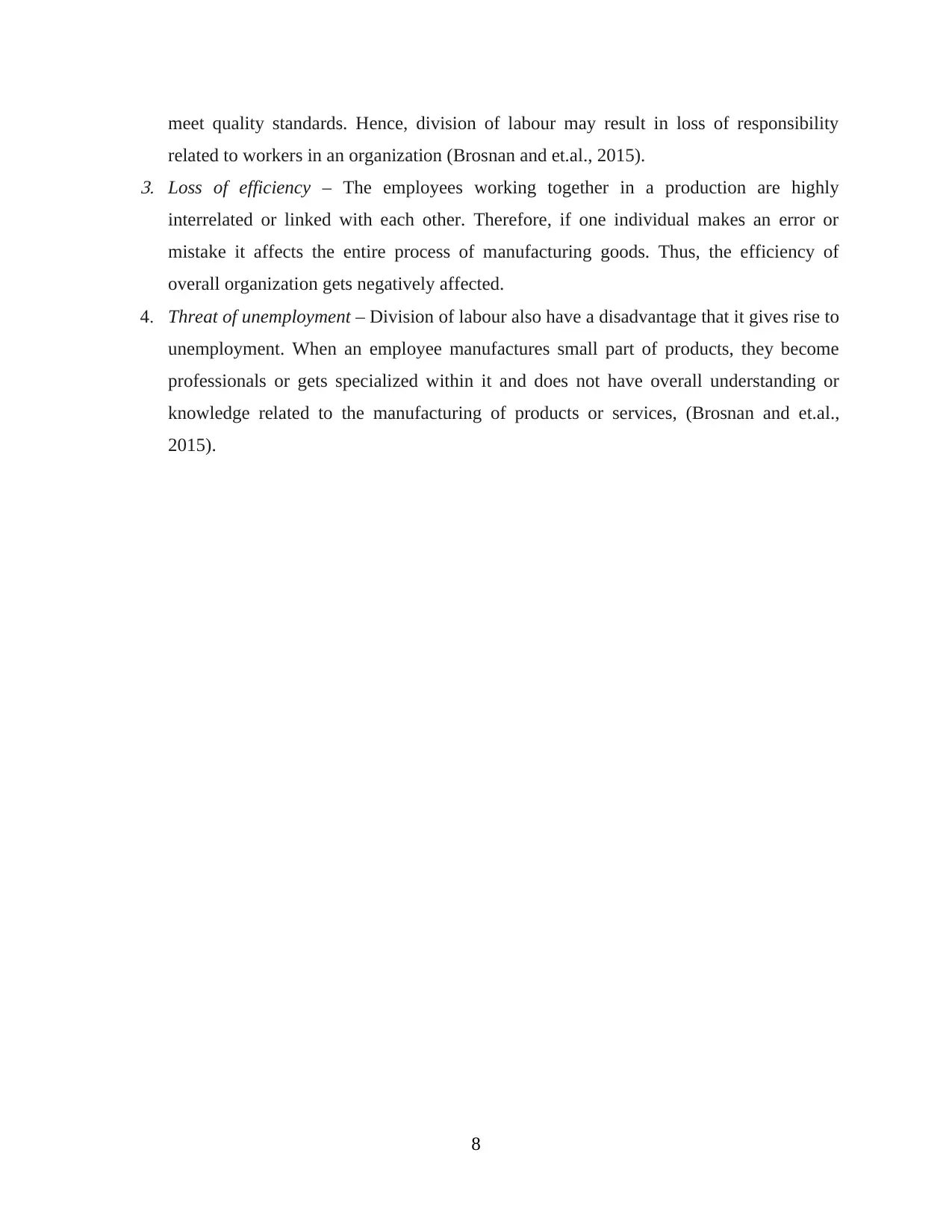
meet quality standards. Hence, division of labour may result in loss of responsibility
related to workers in an organization (Brosnan and et.al., 2015).3. Loss of efficiency – The employees working together in a production are highly
interrelated or linked with each other. Therefore, if one individual makes an error or
mistake it affects the entire process of manufacturing goods. Thus, the efficiency of
overall organization gets negatively affected.
4. Threat of unemployment – Division of labour also have a disadvantage that it gives rise to
unemployment. When an employee manufactures small part of products, they become
professionals or gets specialized within it and does not have overall understanding or
knowledge related to the manufacturing of products or services, (Brosnan and et.al.,
2015).
8
related to workers in an organization (Brosnan and et.al., 2015).3. Loss of efficiency – The employees working together in a production are highly
interrelated or linked with each other. Therefore, if one individual makes an error or
mistake it affects the entire process of manufacturing goods. Thus, the efficiency of
overall organization gets negatively affected.
4. Threat of unemployment – Division of labour also have a disadvantage that it gives rise to
unemployment. When an employee manufactures small part of products, they become
professionals or gets specialized within it and does not have overall understanding or
knowledge related to the manufacturing of products or services, (Brosnan and et.al.,
2015).
8
Secure Best Marks with AI Grader
Need help grading? Try our AI Grader for instant feedback on your assignments.
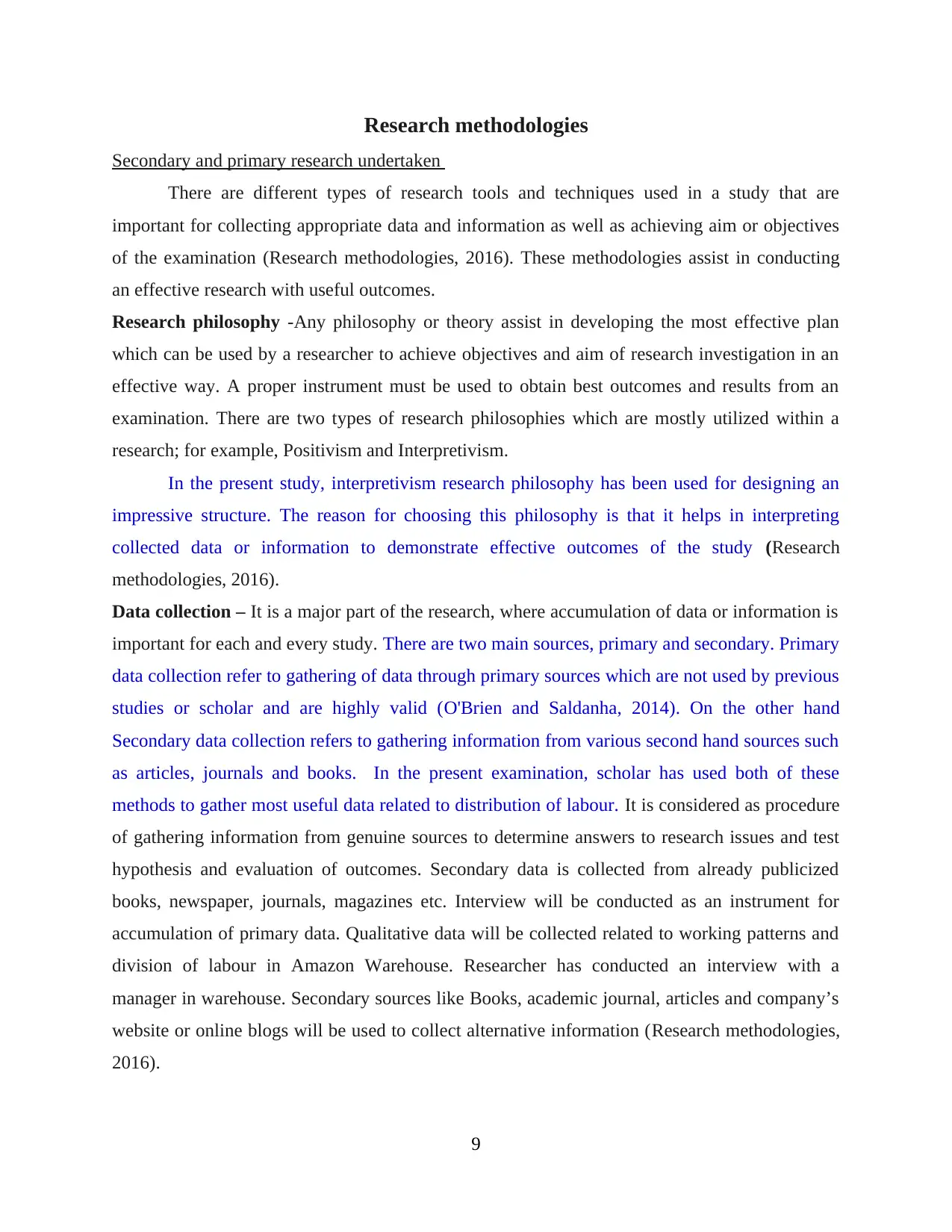
Research methodologies
Secondary and primary research undertaken
There are different types of research tools and techniques used in a study that are
important for collecting appropriate data and information as well as achieving aim or objectives
of the examination (Research methodologies, 2016). These methodologies assist in conducting
an effective research with useful outcomes.
Research philosophy -Any philosophy or theory assist in developing the most effective plan
which can be used by a researcher to achieve objectives and aim of research investigation in an
effective way. A proper instrument must be used to obtain best outcomes and results from an
examination. There are two types of research philosophies which are mostly utilized within a
research; for example, Positivism and Interpretivism.
In the present study, interpretivism research philosophy has been used for designing an
impressive structure. The reason for choosing this philosophy is that it helps in interpreting
collected data or information to demonstrate effective outcomes of the study (Research
methodologies, 2016).
Data collection – It is a major part of the research, where accumulation of data or information is
important for each and every study. There are two main sources, primary and secondary. Primary
data collection refer to gathering of data through primary sources which are not used by previous
studies or scholar and are highly valid (O'Brien and Saldanha, 2014). On the other hand
Secondary data collection refers to gathering information from various second hand sources such
as articles, journals and books. In the present examination, scholar has used both of these
methods to gather most useful data related to distribution of labour. It is considered as procedure
of gathering information from genuine sources to determine answers to research issues and test
hypothesis and evaluation of outcomes. Secondary data is collected from already publicized
books, newspaper, journals, magazines etc. Interview will be conducted as an instrument for
accumulation of primary data. Qualitative data will be collected related to working patterns and
division of labour in Amazon Warehouse. Researcher has conducted an interview with a
manager in warehouse. Secondary sources like Books, academic journal, articles and company’s
website or online blogs will be used to collect alternative information (Research methodologies,
2016).
9
Secondary and primary research undertaken
There are different types of research tools and techniques used in a study that are
important for collecting appropriate data and information as well as achieving aim or objectives
of the examination (Research methodologies, 2016). These methodologies assist in conducting
an effective research with useful outcomes.
Research philosophy -Any philosophy or theory assist in developing the most effective plan
which can be used by a researcher to achieve objectives and aim of research investigation in an
effective way. A proper instrument must be used to obtain best outcomes and results from an
examination. There are two types of research philosophies which are mostly utilized within a
research; for example, Positivism and Interpretivism.
In the present study, interpretivism research philosophy has been used for designing an
impressive structure. The reason for choosing this philosophy is that it helps in interpreting
collected data or information to demonstrate effective outcomes of the study (Research
methodologies, 2016).
Data collection – It is a major part of the research, where accumulation of data or information is
important for each and every study. There are two main sources, primary and secondary. Primary
data collection refer to gathering of data through primary sources which are not used by previous
studies or scholar and are highly valid (O'Brien and Saldanha, 2014). On the other hand
Secondary data collection refers to gathering information from various second hand sources such
as articles, journals and books. In the present examination, scholar has used both of these
methods to gather most useful data related to distribution of labour. It is considered as procedure
of gathering information from genuine sources to determine answers to research issues and test
hypothesis and evaluation of outcomes. Secondary data is collected from already publicized
books, newspaper, journals, magazines etc. Interview will be conducted as an instrument for
accumulation of primary data. Qualitative data will be collected related to working patterns and
division of labour in Amazon Warehouse. Researcher has conducted an interview with a
manager in warehouse. Secondary sources like Books, academic journal, articles and company’s
website or online blogs will be used to collect alternative information (Research methodologies,
2016).
9

Sampling – It refers to choice of a target group through which data has to be gathered. This is
also a useful technique for collecting the most suitable data from various individuals. Sampling
techniques have been segmented in two classes such as probabilistic and non-probabilistic
theories. As study is qualitative in nature, Simple Random Sampling Method will be utilized by
researcher for selecting sample method. Philosophy behind selection of this theory is that it
eliminates biases from selection processes (Research methodologies, 2016). Through this simple
random sampling technique, 1 manager of Amazon F.C has been chosen as sample size amongst
the big population of employees in Amazon Warehouse.
Ethical considerations - There are various ethical considerations which are necessary to be
followed while conducting any research. There are different codes and ethics needed to be
considered such as honesty, society, confidentiality, responsibility, and non-discrimination.
Researcher must make sure that each and every ethical code is taken into consideration while
conducting the research. The managers have been informed about procedure of examination,
approval was taken before conducting the interview. This helped in obtaining the best results and
outcomes from research study (Brosnan and et.al., 2015).
Validity – It can refer as reality of examination or study conducted by a scholar and this depends
upon various factors such as publishing date of various books or articles through which data is
collected. There are different issues which can affect an examination such as morality,
maturation, testing and ambiguity that can harm entire research, therefore it is important to
consider all these elements in data collection and analysis of the same.
Source of error – There is a great probability of errors in accumulation of data and its analysis
which can be eliminated if determined at the right time. There are various ways in which faults
can occur; for example, interpretation, processing, etc. While collecting research data, there are
probabilities for measuring problems or issues. Proper revisions of interview or other research
activities can help in avoiding any type of obstacles in the examination (Research methodologies,
2016).
10
also a useful technique for collecting the most suitable data from various individuals. Sampling
techniques have been segmented in two classes such as probabilistic and non-probabilistic
theories. As study is qualitative in nature, Simple Random Sampling Method will be utilized by
researcher for selecting sample method. Philosophy behind selection of this theory is that it
eliminates biases from selection processes (Research methodologies, 2016). Through this simple
random sampling technique, 1 manager of Amazon F.C has been chosen as sample size amongst
the big population of employees in Amazon Warehouse.
Ethical considerations - There are various ethical considerations which are necessary to be
followed while conducting any research. There are different codes and ethics needed to be
considered such as honesty, society, confidentiality, responsibility, and non-discrimination.
Researcher must make sure that each and every ethical code is taken into consideration while
conducting the research. The managers have been informed about procedure of examination,
approval was taken before conducting the interview. This helped in obtaining the best results and
outcomes from research study (Brosnan and et.al., 2015).
Validity – It can refer as reality of examination or study conducted by a scholar and this depends
upon various factors such as publishing date of various books or articles through which data is
collected. There are different issues which can affect an examination such as morality,
maturation, testing and ambiguity that can harm entire research, therefore it is important to
consider all these elements in data collection and analysis of the same.
Source of error – There is a great probability of errors in accumulation of data and its analysis
which can be eliminated if determined at the right time. There are various ways in which faults
can occur; for example, interpretation, processing, etc. While collecting research data, there are
probabilities for measuring problems or issues. Proper revisions of interview or other research
activities can help in avoiding any type of obstacles in the examination (Research methodologies,
2016).
10
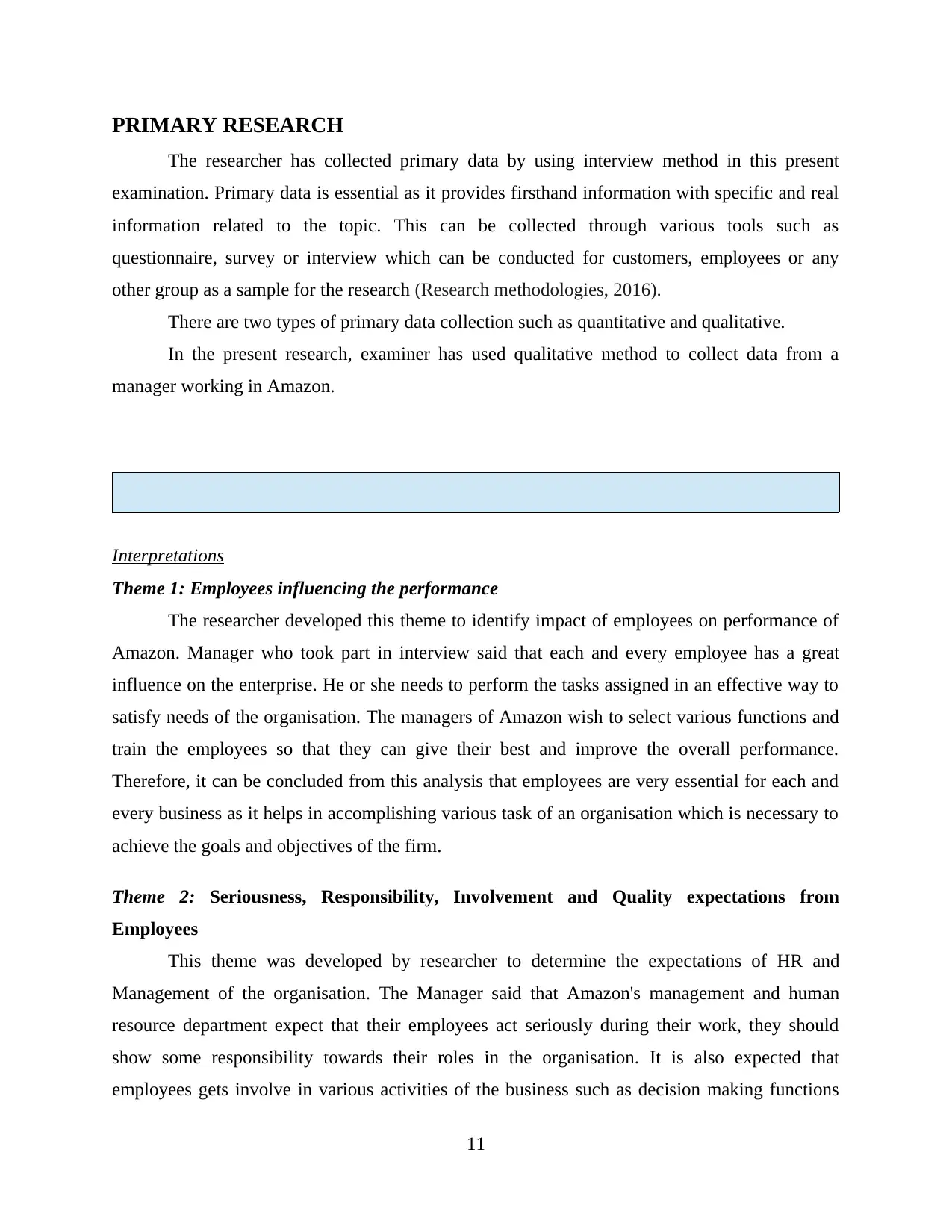
PRIMARY RESEARCH
The researcher has collected primary data by using interview method in this present
examination. Primary data is essential as it provides firsthand information with specific and real
information related to the topic. This can be collected through various tools such as
questionnaire, survey or interview which can be conducted for customers, employees or any
other group as a sample for the research (Research methodologies, 2016).
There are two types of primary data collection such as quantitative and qualitative.
In the present research, examiner has used qualitative method to collect data from a
manager working in Amazon.
Interpretations
Theme 1: Employees influencing the performance
The researcher developed this theme to identify impact of employees on performance of
Amazon. Manager who took part in interview said that each and every employee has a great
influence on the enterprise. He or she needs to perform the tasks assigned in an effective way to
satisfy needs of the organisation. The managers of Amazon wish to select various functions and
train the employees so that they can give their best and improve the overall performance.
Therefore, it can be concluded from this analysis that employees are very essential for each and
every business as it helps in accomplishing various task of an organisation which is necessary to
achieve the goals and objectives of the firm.
Theme 2: Seriousness, Responsibility, Involvement and Quality expectations from
Employees
This theme was developed by researcher to determine the expectations of HR and
Management of the organisation. The Manager said that Amazon's management and human
resource department expect that their employees act seriously during their work, they should
show some responsibility towards their roles in the organisation. It is also expected that
employees gets involve in various activities of the business such as decision making functions
11
The researcher has collected primary data by using interview method in this present
examination. Primary data is essential as it provides firsthand information with specific and real
information related to the topic. This can be collected through various tools such as
questionnaire, survey or interview which can be conducted for customers, employees or any
other group as a sample for the research (Research methodologies, 2016).
There are two types of primary data collection such as quantitative and qualitative.
In the present research, examiner has used qualitative method to collect data from a
manager working in Amazon.
Interpretations
Theme 1: Employees influencing the performance
The researcher developed this theme to identify impact of employees on performance of
Amazon. Manager who took part in interview said that each and every employee has a great
influence on the enterprise. He or she needs to perform the tasks assigned in an effective way to
satisfy needs of the organisation. The managers of Amazon wish to select various functions and
train the employees so that they can give their best and improve the overall performance.
Therefore, it can be concluded from this analysis that employees are very essential for each and
every business as it helps in accomplishing various task of an organisation which is necessary to
achieve the goals and objectives of the firm.
Theme 2: Seriousness, Responsibility, Involvement and Quality expectations from
Employees
This theme was developed by researcher to determine the expectations of HR and
Management of the organisation. The Manager said that Amazon's management and human
resource department expect that their employees act seriously during their work, they should
show some responsibility towards their roles in the organisation. It is also expected that
employees gets involve in various activities of the business such as decision making functions
11
Paraphrase This Document
Need a fresh take? Get an instant paraphrase of this document with our AI Paraphraser
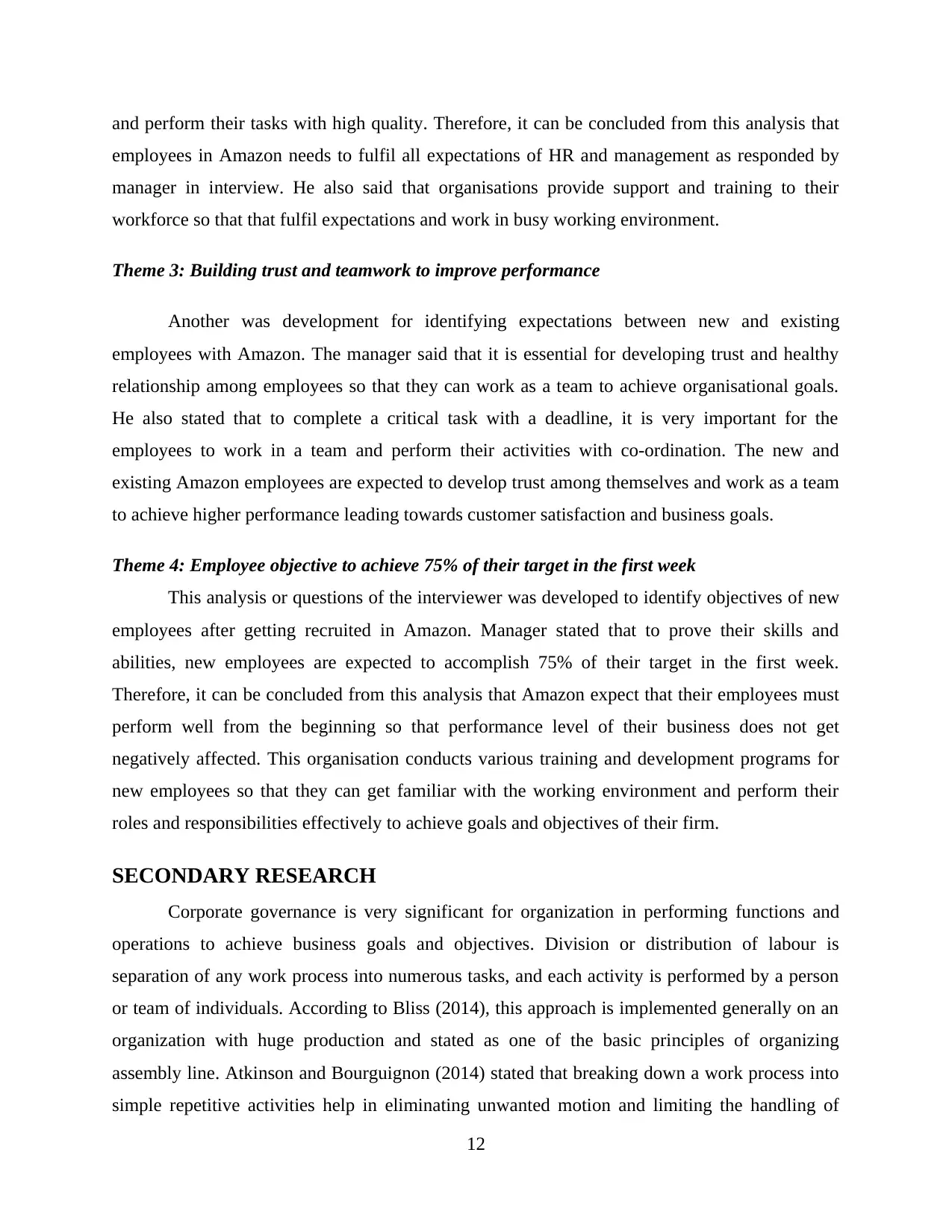
and perform their tasks with high quality. Therefore, it can be concluded from this analysis that
employees in Amazon needs to fulfil all expectations of HR and management as responded by
manager in interview. He also said that organisations provide support and training to their
workforce so that that fulfil expectations and work in busy working environment.
Theme 3: Building trust and teamwork to improve performance
Another was development for identifying expectations between new and existing
employees with Amazon. The manager said that it is essential for developing trust and healthy
relationship among employees so that they can work as a team to achieve organisational goals.
He also stated that to complete a critical task with a deadline, it is very important for the
employees to work in a team and perform their activities with co-ordination. The new and
existing Amazon employees are expected to develop trust among themselves and work as a team
to achieve higher performance leading towards customer satisfaction and business goals.
Theme 4: Employee objective to achieve 75% of their target in the first week
This analysis or questions of the interviewer was developed to identify objectives of new
employees after getting recruited in Amazon. Manager stated that to prove their skills and
abilities, new employees are expected to accomplish 75% of their target in the first week.
Therefore, it can be concluded from this analysis that Amazon expect that their employees must
perform well from the beginning so that performance level of their business does not get
negatively affected. This organisation conducts various training and development programs for
new employees so that they can get familiar with the working environment and perform their
roles and responsibilities effectively to achieve goals and objectives of their firm.
SECONDARY RESEARCH
Corporate governance is very significant for organization in performing functions and
operations to achieve business goals and objectives. Division or distribution of labour is
separation of any work process into numerous tasks, and each activity is performed by a person
or team of individuals. According to Bliss (2014), this approach is implemented generally on an
organization with huge production and stated as one of the basic principles of organizing
assembly line. Atkinson and Bourguignon (2014) stated that breaking down a work process into
simple repetitive activities help in eliminating unwanted motion and limiting the handling of
12
employees in Amazon needs to fulfil all expectations of HR and management as responded by
manager in interview. He also said that organisations provide support and training to their
workforce so that that fulfil expectations and work in busy working environment.
Theme 3: Building trust and teamwork to improve performance
Another was development for identifying expectations between new and existing
employees with Amazon. The manager said that it is essential for developing trust and healthy
relationship among employees so that they can work as a team to achieve organisational goals.
He also stated that to complete a critical task with a deadline, it is very important for the
employees to work in a team and perform their activities with co-ordination. The new and
existing Amazon employees are expected to develop trust among themselves and work as a team
to achieve higher performance leading towards customer satisfaction and business goals.
Theme 4: Employee objective to achieve 75% of their target in the first week
This analysis or questions of the interviewer was developed to identify objectives of new
employees after getting recruited in Amazon. Manager stated that to prove their skills and
abilities, new employees are expected to accomplish 75% of their target in the first week.
Therefore, it can be concluded from this analysis that Amazon expect that their employees must
perform well from the beginning so that performance level of their business does not get
negatively affected. This organisation conducts various training and development programs for
new employees so that they can get familiar with the working environment and perform their
roles and responsibilities effectively to achieve goals and objectives of their firm.
SECONDARY RESEARCH
Corporate governance is very significant for organization in performing functions and
operations to achieve business goals and objectives. Division or distribution of labour is
separation of any work process into numerous tasks, and each activity is performed by a person
or team of individuals. According to Bliss (2014), this approach is implemented generally on an
organization with huge production and stated as one of the basic principles of organizing
assembly line. Atkinson and Bourguignon (2014) stated that breaking down a work process into
simple repetitive activities help in eliminating unwanted motion and limiting the handling of
12
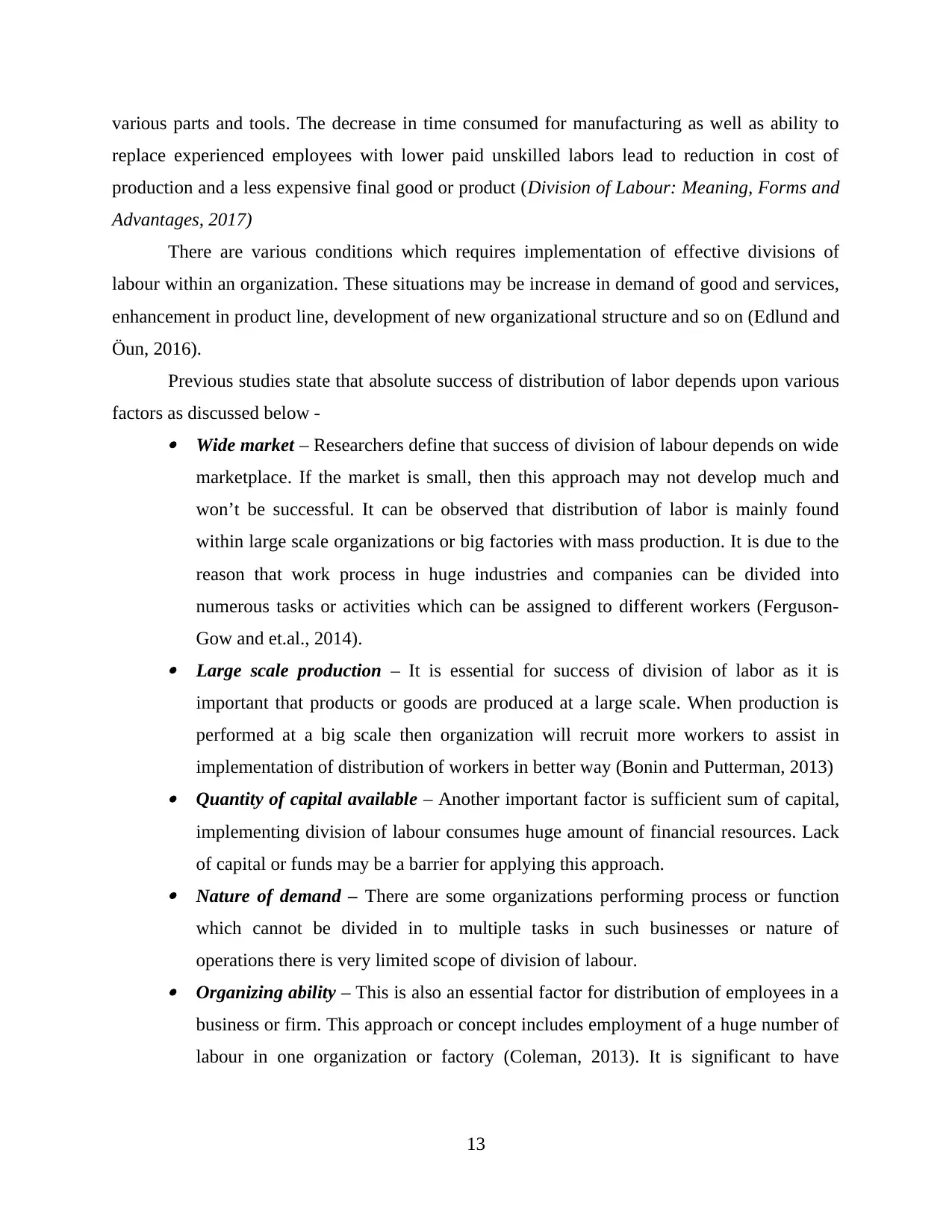
various parts and tools. The decrease in time consumed for manufacturing as well as ability to
replace experienced employees with lower paid unskilled labors lead to reduction in cost of
production and a less expensive final good or product (Division of Labour: Meaning, Forms and
Advantages, 2017)
There are various conditions which requires implementation of effective divisions of
labour within an organization. These situations may be increase in demand of good and services,
enhancement in product line, development of new organizational structure and so on (Edlund and
Öun, 2016).
Previous studies state that absolute success of distribution of labor depends upon various
factors as discussed below -
Wide market – Researchers define that success of division of labour depends on wide
marketplace. If the market is small, then this approach may not develop much and
won’t be successful. It can be observed that distribution of labor is mainly found
within large scale organizations or big factories with mass production. It is due to the
reason that work process in huge industries and companies can be divided into
numerous tasks or activities which can be assigned to different workers (Ferguson-
Gow and et.al., 2014).
Large scale production – It is essential for success of division of labor as it is
important that products or goods are produced at a large scale. When production is
performed at a big scale then organization will recruit more workers to assist in
implementation of distribution of workers in better way (Bonin and Putterman, 2013)
Quantity of capital available – Another important factor is sufficient sum of capital,
implementing division of labour consumes huge amount of financial resources. Lack
of capital or funds may be a barrier for applying this approach.
Nature of demand – There are some organizations performing process or function
which cannot be divided in to multiple tasks in such businesses or nature of
operations there is very limited scope of division of labour.
Organizing ability – This is also an essential factor for distribution of employees in a
business or firm. This approach or concept includes employment of a huge number of
labour in one organization or factory (Coleman, 2013). It is significant to have
13
replace experienced employees with lower paid unskilled labors lead to reduction in cost of
production and a less expensive final good or product (Division of Labour: Meaning, Forms and
Advantages, 2017)
There are various conditions which requires implementation of effective divisions of
labour within an organization. These situations may be increase in demand of good and services,
enhancement in product line, development of new organizational structure and so on (Edlund and
Öun, 2016).
Previous studies state that absolute success of distribution of labor depends upon various
factors as discussed below -
Wide market – Researchers define that success of division of labour depends on wide
marketplace. If the market is small, then this approach may not develop much and
won’t be successful. It can be observed that distribution of labor is mainly found
within large scale organizations or big factories with mass production. It is due to the
reason that work process in huge industries and companies can be divided into
numerous tasks or activities which can be assigned to different workers (Ferguson-
Gow and et.al., 2014).
Large scale production – It is essential for success of division of labor as it is
important that products or goods are produced at a large scale. When production is
performed at a big scale then organization will recruit more workers to assist in
implementation of distribution of workers in better way (Bonin and Putterman, 2013)
Quantity of capital available – Another important factor is sufficient sum of capital,
implementing division of labour consumes huge amount of financial resources. Lack
of capital or funds may be a barrier for applying this approach.
Nature of demand – There are some organizations performing process or function
which cannot be divided in to multiple tasks in such businesses or nature of
operations there is very limited scope of division of labour.
Organizing ability – This is also an essential factor for distribution of employees in a
business or firm. This approach or concept includes employment of a huge number of
labour in one organization or factory (Coleman, 2013). It is significant to have
13
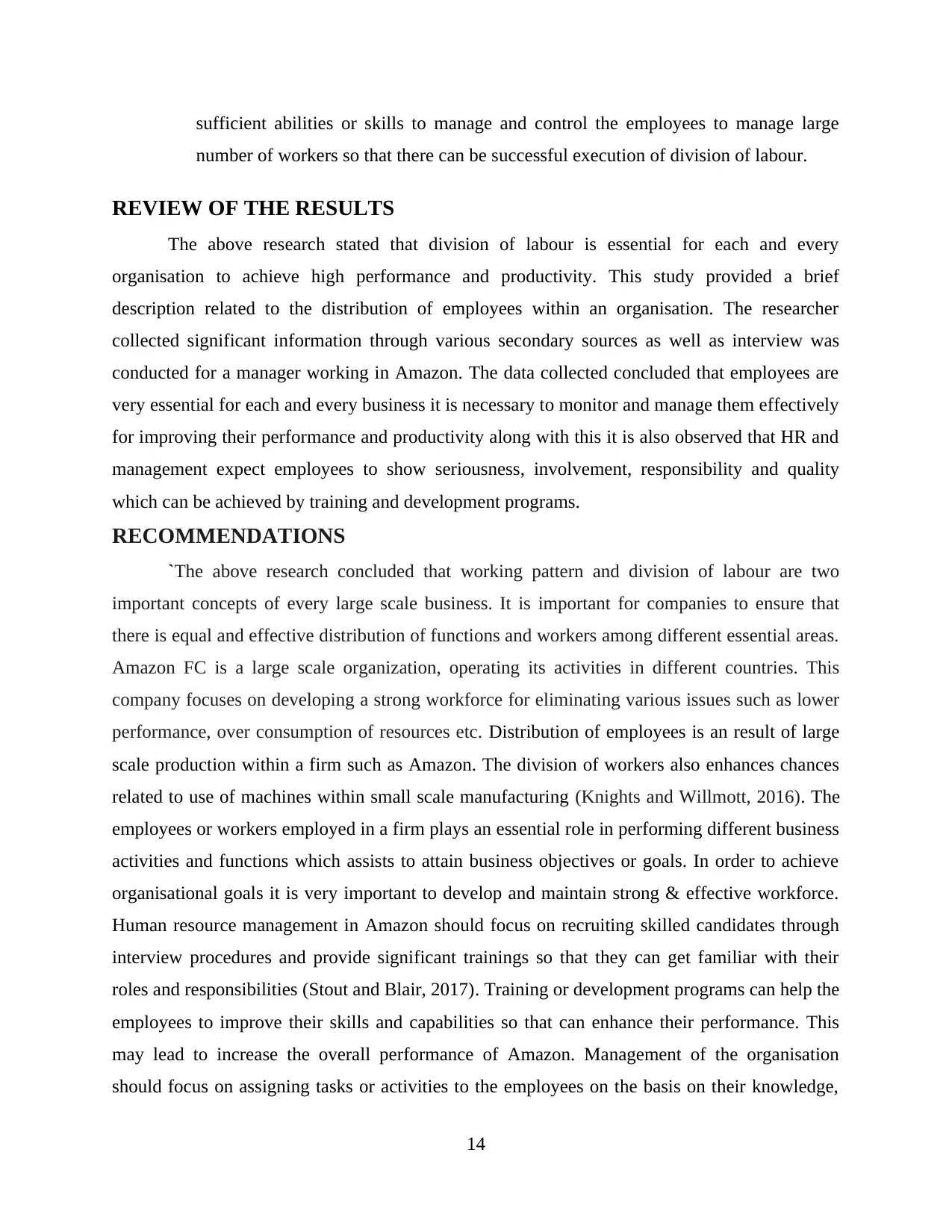
sufficient abilities or skills to manage and control the employees to manage large
number of workers so that there can be successful execution of division of labour.
REVIEW OF THE RESULTS
The above research stated that division of labour is essential for each and every
organisation to achieve high performance and productivity. This study provided a brief
description related to the distribution of employees within an organisation. The researcher
collected significant information through various secondary sources as well as interview was
conducted for a manager working in Amazon. The data collected concluded that employees are
very essential for each and every business it is necessary to monitor and manage them effectively
for improving their performance and productivity along with this it is also observed that HR and
management expect employees to show seriousness, involvement, responsibility and quality
which can be achieved by training and development programs.
RECOMMENDATIONS
`The above research concluded that working pattern and division of labour are two
important concepts of every large scale business. It is important for companies to ensure that
there is equal and effective distribution of functions and workers among different essential areas.
Amazon FC is a large scale organization, operating its activities in different countries. This
company focuses on developing a strong workforce for eliminating various issues such as lower
performance, over consumption of resources etc. Distribution of employees is an result of large
scale production within a firm such as Amazon. The division of workers also enhances chances
related to use of machines within small scale manufacturing (Knights and Willmott, 2016). The
employees or workers employed in a firm plays an essential role in performing different business
activities and functions which assists to attain business objectives or goals. In order to achieve
organisational goals it is very important to develop and maintain strong & effective workforce.
Human resource management in Amazon should focus on recruiting skilled candidates through
interview procedures and provide significant trainings so that they can get familiar with their
roles and responsibilities (Stout and Blair, 2017). Training or development programs can help the
employees to improve their skills and capabilities so that can enhance their performance. This
may lead to increase the overall performance of Amazon. Management of the organisation
should focus on assigning tasks or activities to the employees on the basis on their knowledge,
14
number of workers so that there can be successful execution of division of labour.
REVIEW OF THE RESULTS
The above research stated that division of labour is essential for each and every
organisation to achieve high performance and productivity. This study provided a brief
description related to the distribution of employees within an organisation. The researcher
collected significant information through various secondary sources as well as interview was
conducted for a manager working in Amazon. The data collected concluded that employees are
very essential for each and every business it is necessary to monitor and manage them effectively
for improving their performance and productivity along with this it is also observed that HR and
management expect employees to show seriousness, involvement, responsibility and quality
which can be achieved by training and development programs.
RECOMMENDATIONS
`The above research concluded that working pattern and division of labour are two
important concepts of every large scale business. It is important for companies to ensure that
there is equal and effective distribution of functions and workers among different essential areas.
Amazon FC is a large scale organization, operating its activities in different countries. This
company focuses on developing a strong workforce for eliminating various issues such as lower
performance, over consumption of resources etc. Distribution of employees is an result of large
scale production within a firm such as Amazon. The division of workers also enhances chances
related to use of machines within small scale manufacturing (Knights and Willmott, 2016). The
employees or workers employed in a firm plays an essential role in performing different business
activities and functions which assists to attain business objectives or goals. In order to achieve
organisational goals it is very important to develop and maintain strong & effective workforce.
Human resource management in Amazon should focus on recruiting skilled candidates through
interview procedures and provide significant trainings so that they can get familiar with their
roles and responsibilities (Stout and Blair, 2017). Training or development programs can help the
employees to improve their skills and capabilities so that can enhance their performance. This
may lead to increase the overall performance of Amazon. Management of the organisation
should focus on assigning tasks or activities to the employees on the basis on their knowledge,
14
Secure Best Marks with AI Grader
Need help grading? Try our AI Grader for instant feedback on your assignments.
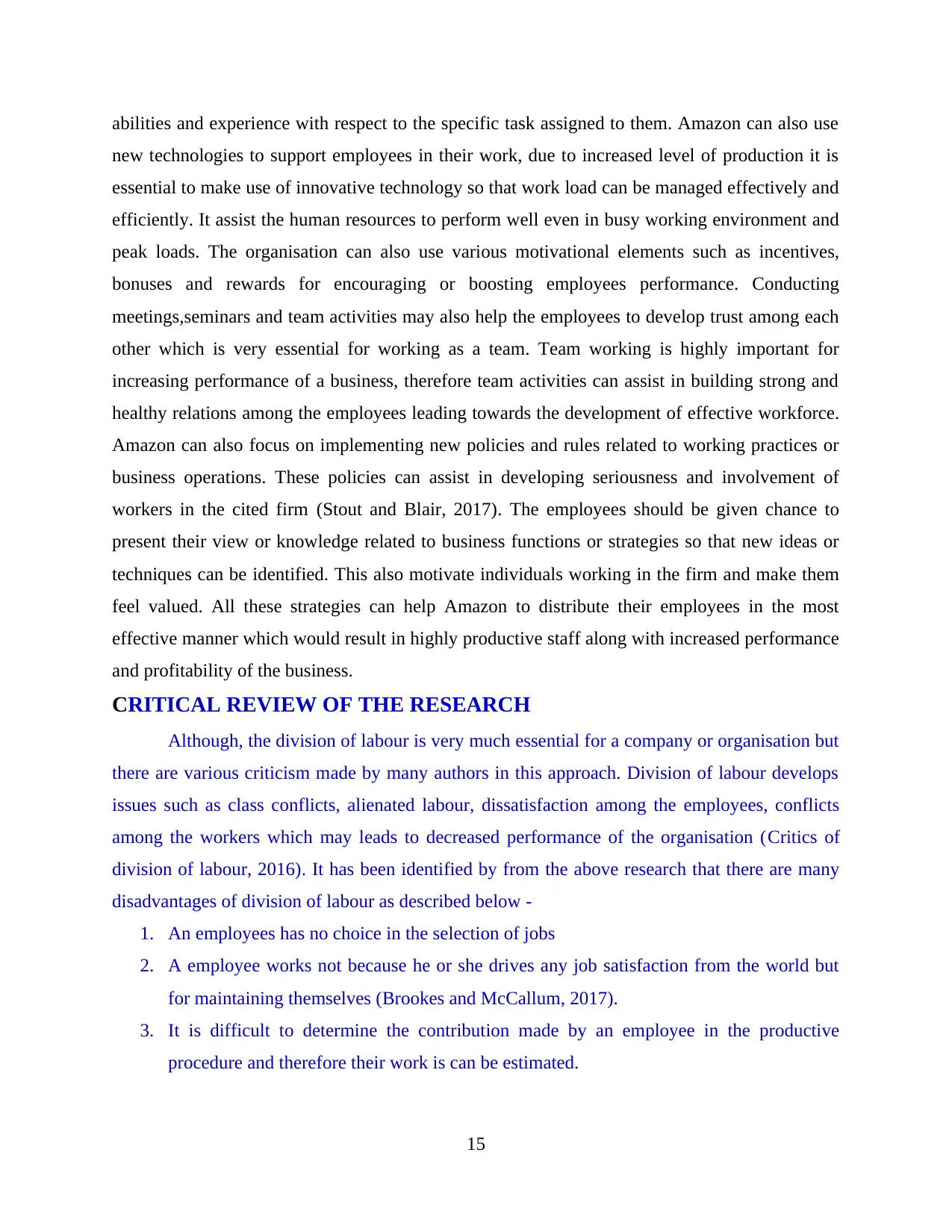
abilities and experience with respect to the specific task assigned to them. Amazon can also use
new technologies to support employees in their work, due to increased level of production it is
essential to make use of innovative technology so that work load can be managed effectively and
efficiently. It assist the human resources to perform well even in busy working environment and
peak loads. The organisation can also use various motivational elements such as incentives,
bonuses and rewards for encouraging or boosting employees performance. Conducting
meetings,seminars and team activities may also help the employees to develop trust among each
other which is very essential for working as a team. Team working is highly important for
increasing performance of a business, therefore team activities can assist in building strong and
healthy relations among the employees leading towards the development of effective workforce.
Amazon can also focus on implementing new policies and rules related to working practices or
business operations. These policies can assist in developing seriousness and involvement of
workers in the cited firm (Stout and Blair, 2017). The employees should be given chance to
present their view or knowledge related to business functions or strategies so that new ideas or
techniques can be identified. This also motivate individuals working in the firm and make them
feel valued. All these strategies can help Amazon to distribute their employees in the most
effective manner which would result in highly productive staff along with increased performance
and profitability of the business.
CRITICAL REVIEW OF THE RESEARCH
Although, the division of labour is very much essential for a company or organisation but
there are various criticism made by many authors in this approach. Division of labour develops
issues such as class conflicts, alienated labour, dissatisfaction among the employees, conflicts
among the workers which may leads to decreased performance of the organisation (Critics of
division of labour, 2016). It has been identified by from the above research that there are many
disadvantages of division of labour as described below -
1. An employees has no choice in the selection of jobs
2. A employee works not because he or she drives any job satisfaction from the world but
for maintaining themselves (Brookes and McCallum, 2017).
3. It is difficult to determine the contribution made by an employee in the productive
procedure and therefore their work is can be estimated.
15
new technologies to support employees in their work, due to increased level of production it is
essential to make use of innovative technology so that work load can be managed effectively and
efficiently. It assist the human resources to perform well even in busy working environment and
peak loads. The organisation can also use various motivational elements such as incentives,
bonuses and rewards for encouraging or boosting employees performance. Conducting
meetings,seminars and team activities may also help the employees to develop trust among each
other which is very essential for working as a team. Team working is highly important for
increasing performance of a business, therefore team activities can assist in building strong and
healthy relations among the employees leading towards the development of effective workforce.
Amazon can also focus on implementing new policies and rules related to working practices or
business operations. These policies can assist in developing seriousness and involvement of
workers in the cited firm (Stout and Blair, 2017). The employees should be given chance to
present their view or knowledge related to business functions or strategies so that new ideas or
techniques can be identified. This also motivate individuals working in the firm and make them
feel valued. All these strategies can help Amazon to distribute their employees in the most
effective manner which would result in highly productive staff along with increased performance
and profitability of the business.
CRITICAL REVIEW OF THE RESEARCH
Although, the division of labour is very much essential for a company or organisation but
there are various criticism made by many authors in this approach. Division of labour develops
issues such as class conflicts, alienated labour, dissatisfaction among the employees, conflicts
among the workers which may leads to decreased performance of the organisation (Critics of
division of labour, 2016). It has been identified by from the above research that there are many
disadvantages of division of labour as described below -
1. An employees has no choice in the selection of jobs
2. A employee works not because he or she drives any job satisfaction from the world but
for maintaining themselves (Brookes and McCallum, 2017).
3. It is difficult to determine the contribution made by an employee in the productive
procedure and therefore their work is can be estimated.
15

4. It also risk of unemployment.
16
16

RESEARCH PROPOSAL
17
17
Paraphrase This Document
Need a fresh take? Get an instant paraphrase of this document with our AI Paraphraser

TABLE OF CONTENTS
PROJECT TITLE.............................................................................................................................3
INTRODUCTION...........................................................................................................................3
LITERATURE REVIEW................................................................................................................5
REFERENCES................................................................................................................................9
PROJECT TITLE.............................................................................................................................3
INTRODUCTION...........................................................................................................................3
LITERATURE REVIEW................................................................................................................5
REFERENCES................................................................................................................................9
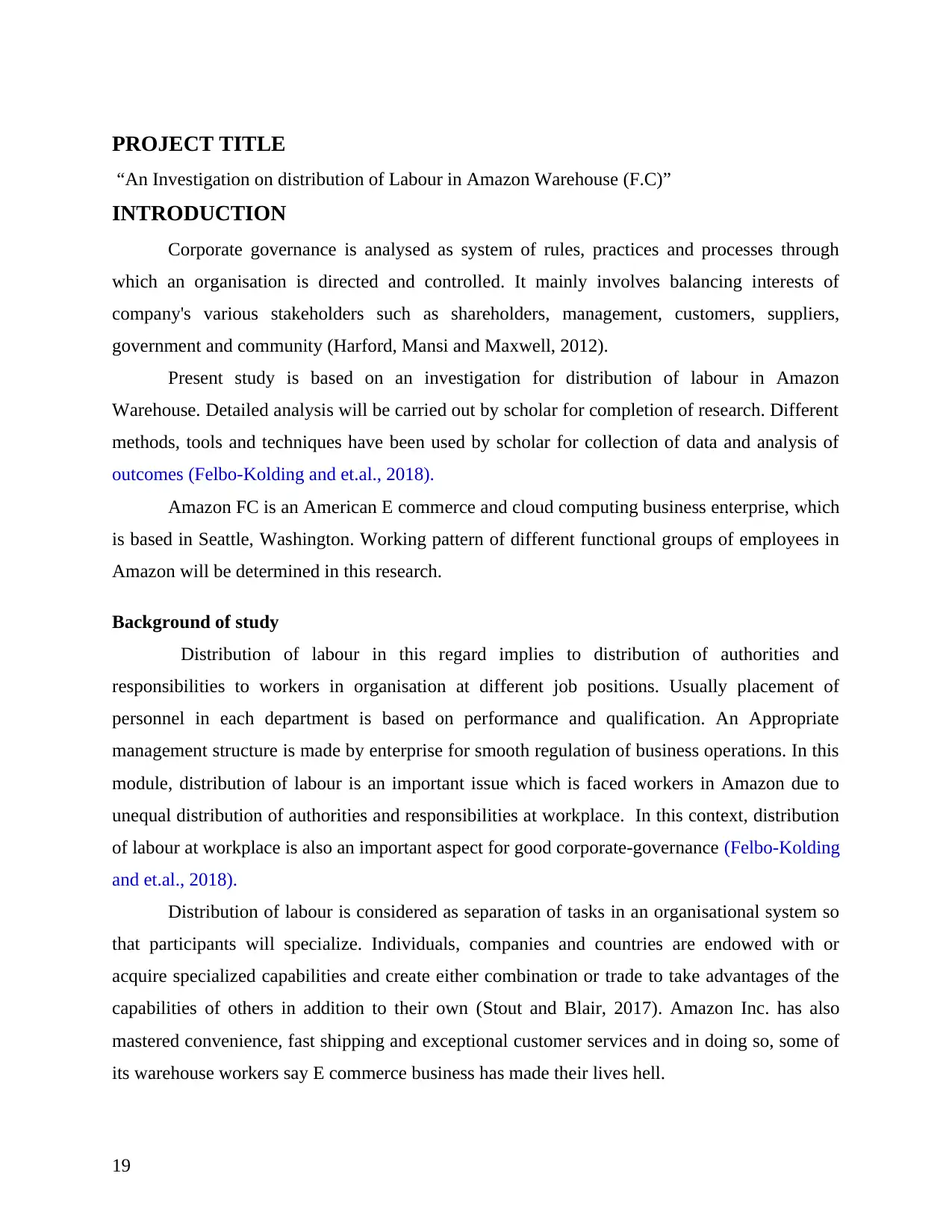
PROJECT TITLE
“An Investigation on distribution of Labour in Amazon Warehouse (F.C)”
INTRODUCTION
Corporate governance is analysed as system of rules, practices and processes through
which an organisation is directed and controlled. It mainly involves balancing interests of
company's various stakeholders such as shareholders, management, customers, suppliers,
government and community (Harford, Mansi and Maxwell, 2012).
Present study is based on an investigation for distribution of labour in Amazon
Warehouse. Detailed analysis will be carried out by scholar for completion of research. Different
methods, tools and techniques have been used by scholar for collection of data and analysis of
outcomes (Felbo-Kolding and et.al., 2018).
Amazon FC is an American E commerce and cloud computing business enterprise, which
is based in Seattle, Washington. Working pattern of different functional groups of employees in
Amazon will be determined in this research.
Background of study
Distribution of labour in this regard implies to distribution of authorities and
responsibilities to workers in organisation at different job positions. Usually placement of
personnel in each department is based on performance and qualification. An Appropriate
management structure is made by enterprise for smooth regulation of business operations. In this
module, distribution of labour is an important issue which is faced workers in Amazon due to
unequal distribution of authorities and responsibilities at workplace. In this context, distribution
of labour at workplace is also an important aspect for good corporate-governance (Felbo-Kolding
and et.al., 2018).
Distribution of labour is considered as separation of tasks in an organisational system so
that participants will specialize. Individuals, companies and countries are endowed with or
acquire specialized capabilities and create either combination or trade to take advantages of the
capabilities of others in addition to their own (Stout and Blair, 2017). Amazon Inc. has also
mastered convenience, fast shipping and exceptional customer services and in doing so, some of
its warehouse workers say E commerce business has made their lives hell.
19
“An Investigation on distribution of Labour in Amazon Warehouse (F.C)”
INTRODUCTION
Corporate governance is analysed as system of rules, practices and processes through
which an organisation is directed and controlled. It mainly involves balancing interests of
company's various stakeholders such as shareholders, management, customers, suppliers,
government and community (Harford, Mansi and Maxwell, 2012).
Present study is based on an investigation for distribution of labour in Amazon
Warehouse. Detailed analysis will be carried out by scholar for completion of research. Different
methods, tools and techniques have been used by scholar for collection of data and analysis of
outcomes (Felbo-Kolding and et.al., 2018).
Amazon FC is an American E commerce and cloud computing business enterprise, which
is based in Seattle, Washington. Working pattern of different functional groups of employees in
Amazon will be determined in this research.
Background of study
Distribution of labour in this regard implies to distribution of authorities and
responsibilities to workers in organisation at different job positions. Usually placement of
personnel in each department is based on performance and qualification. An Appropriate
management structure is made by enterprise for smooth regulation of business operations. In this
module, distribution of labour is an important issue which is faced workers in Amazon due to
unequal distribution of authorities and responsibilities at workplace. In this context, distribution
of labour at workplace is also an important aspect for good corporate-governance (Felbo-Kolding
and et.al., 2018).
Distribution of labour is considered as separation of tasks in an organisational system so
that participants will specialize. Individuals, companies and countries are endowed with or
acquire specialized capabilities and create either combination or trade to take advantages of the
capabilities of others in addition to their own (Stout and Blair, 2017). Amazon Inc. has also
mastered convenience, fast shipping and exceptional customer services and in doing so, some of
its warehouse workers say E commerce business has made their lives hell.
19
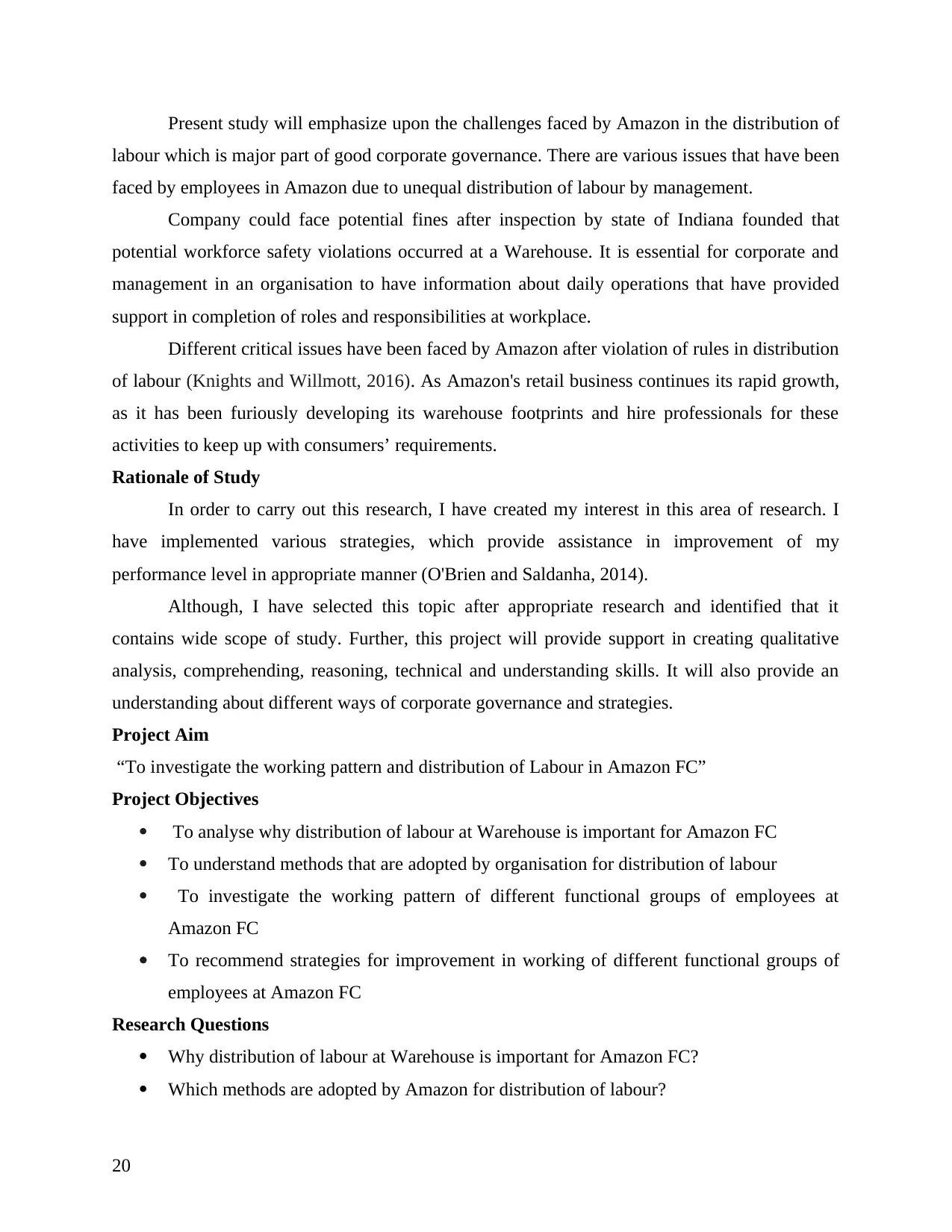
Present study will emphasize upon the challenges faced by Amazon in the distribution of
labour which is major part of good corporate governance. There are various issues that have been
faced by employees in Amazon due to unequal distribution of labour by management.
Company could face potential fines after inspection by state of Indiana founded that
potential workforce safety violations occurred at a Warehouse. It is essential for corporate and
management in an organisation to have information about daily operations that have provided
support in completion of roles and responsibilities at workplace.
Different critical issues have been faced by Amazon after violation of rules in distribution
of labour (Knights and Willmott, 2016). As Amazon's retail business continues its rapid growth,
as it has been furiously developing its warehouse footprints and hire professionals for these
activities to keep up with consumers’ requirements.
Rationale of Study
In order to carry out this research, I have created my interest in this area of research. I
have implemented various strategies, which provide assistance in improvement of my
performance level in appropriate manner (O'Brien and Saldanha, 2014).
Although, I have selected this topic after appropriate research and identified that it
contains wide scope of study. Further, this project will provide support in creating qualitative
analysis, comprehending, reasoning, technical and understanding skills. It will also provide an
understanding about different ways of corporate governance and strategies.
Project Aim
“To investigate the working pattern and distribution of Labour in Amazon FC”
Project Objectives
To analyse why distribution of labour at Warehouse is important for Amazon FC
To understand methods that are adopted by organisation for distribution of labour
To investigate the working pattern of different functional groups of employees at
Amazon FC
To recommend strategies for improvement in working of different functional groups of
employees at Amazon FC
Research Questions
Why distribution of labour at Warehouse is important for Amazon FC?
Which methods are adopted by Amazon for distribution of labour?
20
labour which is major part of good corporate governance. There are various issues that have been
faced by employees in Amazon due to unequal distribution of labour by management.
Company could face potential fines after inspection by state of Indiana founded that
potential workforce safety violations occurred at a Warehouse. It is essential for corporate and
management in an organisation to have information about daily operations that have provided
support in completion of roles and responsibilities at workplace.
Different critical issues have been faced by Amazon after violation of rules in distribution
of labour (Knights and Willmott, 2016). As Amazon's retail business continues its rapid growth,
as it has been furiously developing its warehouse footprints and hire professionals for these
activities to keep up with consumers’ requirements.
Rationale of Study
In order to carry out this research, I have created my interest in this area of research. I
have implemented various strategies, which provide assistance in improvement of my
performance level in appropriate manner (O'Brien and Saldanha, 2014).
Although, I have selected this topic after appropriate research and identified that it
contains wide scope of study. Further, this project will provide support in creating qualitative
analysis, comprehending, reasoning, technical and understanding skills. It will also provide an
understanding about different ways of corporate governance and strategies.
Project Aim
“To investigate the working pattern and distribution of Labour in Amazon FC”
Project Objectives
To analyse why distribution of labour at Warehouse is important for Amazon FC
To understand methods that are adopted by organisation for distribution of labour
To investigate the working pattern of different functional groups of employees at
Amazon FC
To recommend strategies for improvement in working of different functional groups of
employees at Amazon FC
Research Questions
Why distribution of labour at Warehouse is important for Amazon FC?
Which methods are adopted by Amazon for distribution of labour?
20
Secure Best Marks with AI Grader
Need help grading? Try our AI Grader for instant feedback on your assignments.
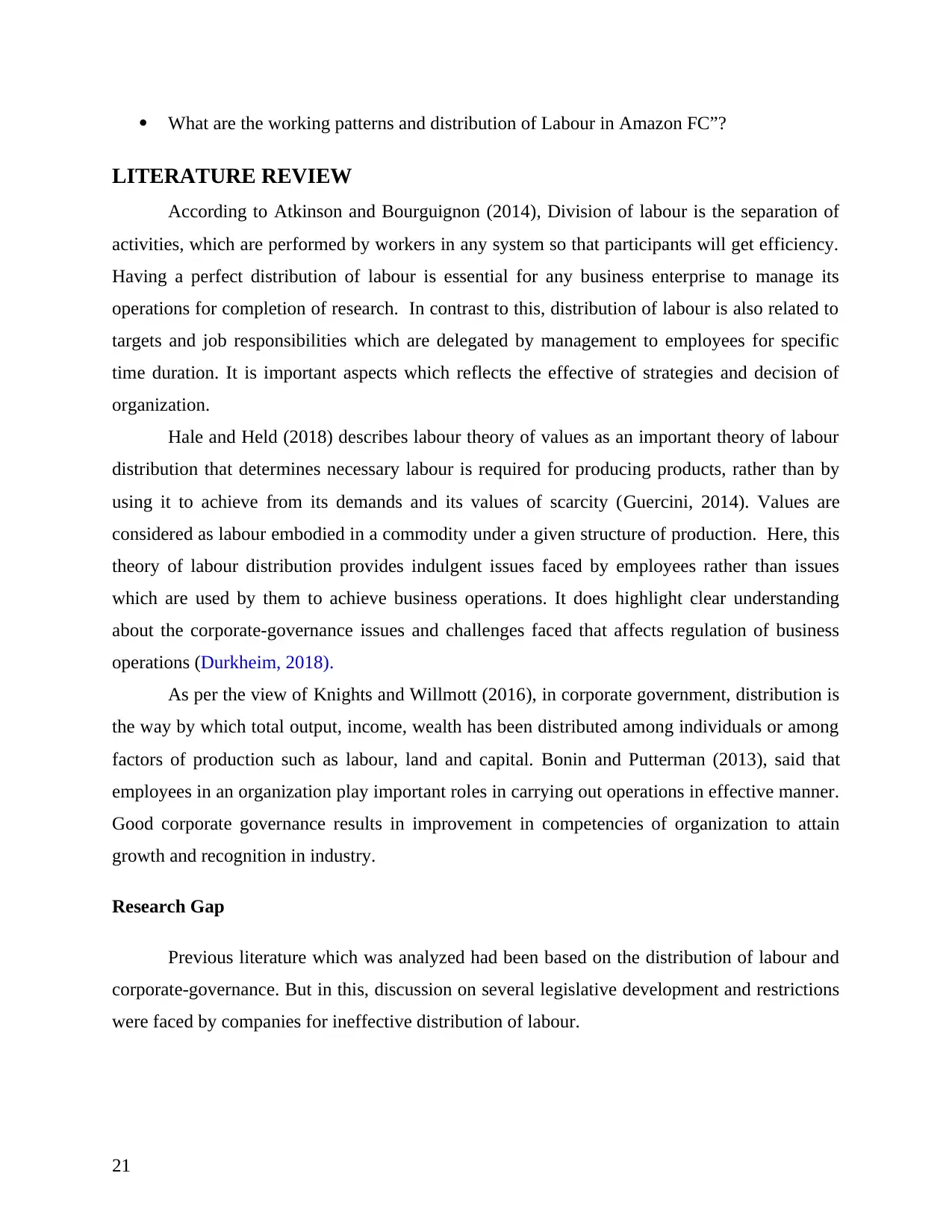
What are the working patterns and distribution of Labour in Amazon FC”?
LITERATURE REVIEW
According to Atkinson and Bourguignon (2014), Division of labour is the separation of
activities, which are performed by workers in any system so that participants will get efficiency.
Having a perfect distribution of labour is essential for any business enterprise to manage its
operations for completion of research. In contrast to this, distribution of labour is also related to
targets and job responsibilities which are delegated by management to employees for specific
time duration. It is important aspects which reflects the effective of strategies and decision of
organization.
Hale and Held (2018) describes labour theory of values as an important theory of labour
distribution that determines necessary labour is required for producing products, rather than by
using it to achieve from its demands and its values of scarcity (Guercini, 2014). Values are
considered as labour embodied in a commodity under a given structure of production. Here, this
theory of labour distribution provides indulgent issues faced by employees rather than issues
which are used by them to achieve business operations. It does highlight clear understanding
about the corporate-governance issues and challenges faced that affects regulation of business
operations (Durkheim, 2018).
As per the view of Knights and Willmott (2016), in corporate government, distribution is
the way by which total output, income, wealth has been distributed among individuals or among
factors of production such as labour, land and capital. Bonin and Putterman (2013), said that
employees in an organization play important roles in carrying out operations in effective manner.
Good corporate governance results in improvement in competencies of organization to attain
growth and recognition in industry.
Research Gap
Previous literature which was analyzed had been based on the distribution of labour and
corporate-governance. But in this, discussion on several legislative development and restrictions
were faced by companies for ineffective distribution of labour.
21
LITERATURE REVIEW
According to Atkinson and Bourguignon (2014), Division of labour is the separation of
activities, which are performed by workers in any system so that participants will get efficiency.
Having a perfect distribution of labour is essential for any business enterprise to manage its
operations for completion of research. In contrast to this, distribution of labour is also related to
targets and job responsibilities which are delegated by management to employees for specific
time duration. It is important aspects which reflects the effective of strategies and decision of
organization.
Hale and Held (2018) describes labour theory of values as an important theory of labour
distribution that determines necessary labour is required for producing products, rather than by
using it to achieve from its demands and its values of scarcity (Guercini, 2014). Values are
considered as labour embodied in a commodity under a given structure of production. Here, this
theory of labour distribution provides indulgent issues faced by employees rather than issues
which are used by them to achieve business operations. It does highlight clear understanding
about the corporate-governance issues and challenges faced that affects regulation of business
operations (Durkheim, 2018).
As per the view of Knights and Willmott (2016), in corporate government, distribution is
the way by which total output, income, wealth has been distributed among individuals or among
factors of production such as labour, land and capital. Bonin and Putterman (2013), said that
employees in an organization play important roles in carrying out operations in effective manner.
Good corporate governance results in improvement in competencies of organization to attain
growth and recognition in industry.
Research Gap
Previous literature which was analyzed had been based on the distribution of labour and
corporate-governance. But in this, discussion on several legislative development and restrictions
were faced by companies for ineffective distribution of labour.
21
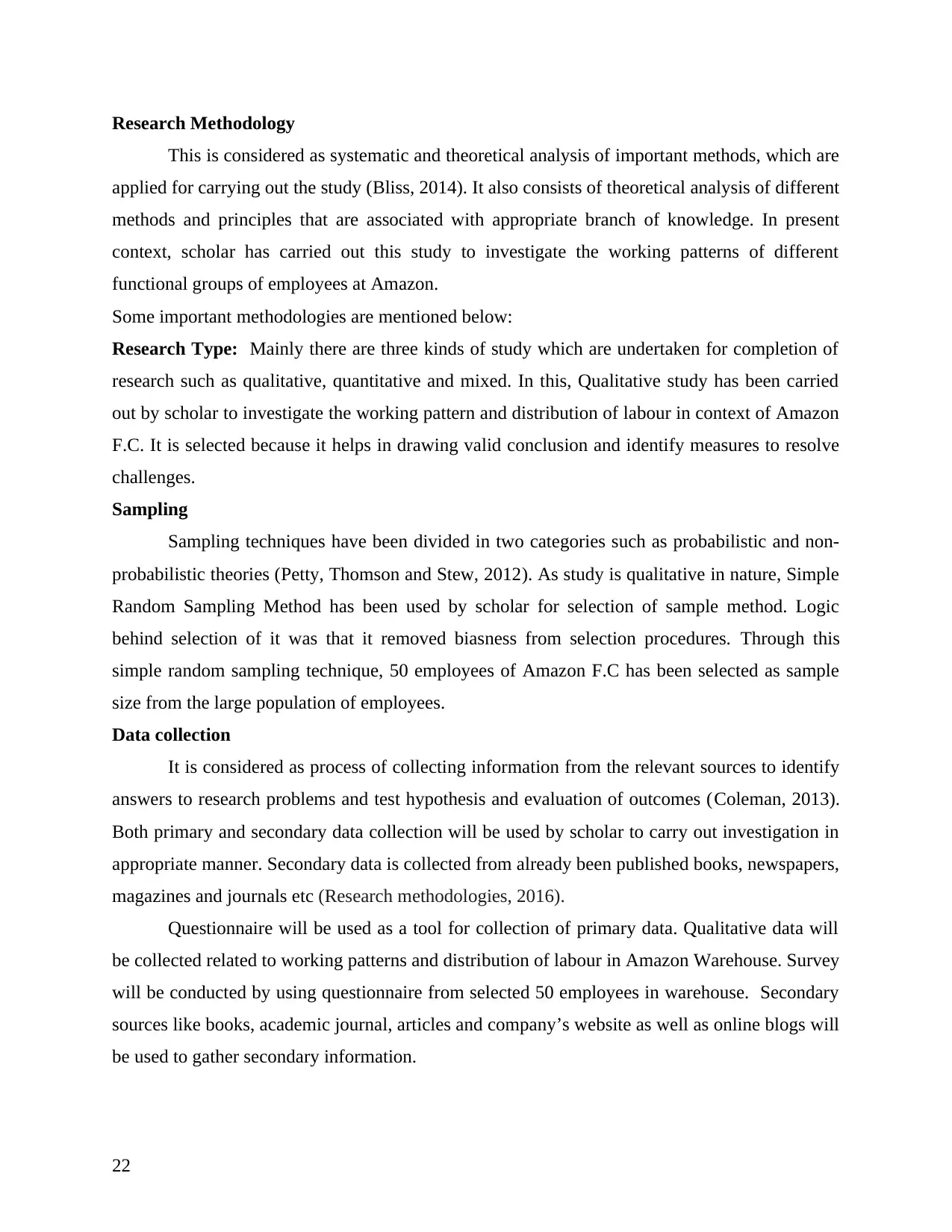
Research Methodology
This is considered as systematic and theoretical analysis of important methods, which are
applied for carrying out the study (Bliss, 2014). It also consists of theoretical analysis of different
methods and principles that are associated with appropriate branch of knowledge. In present
context, scholar has carried out this study to investigate the working patterns of different
functional groups of employees at Amazon.
Some important methodologies are mentioned below:
Research Type: Mainly there are three kinds of study which are undertaken for completion of
research such as qualitative, quantitative and mixed. In this, Qualitative study has been carried
out by scholar to investigate the working pattern and distribution of labour in context of Amazon
F.C. It is selected because it helps in drawing valid conclusion and identify measures to resolve
challenges.
Sampling
Sampling techniques have been divided in two categories such as probabilistic and non-
probabilistic theories (Petty, Thomson and Stew, 2012). As study is qualitative in nature, Simple
Random Sampling Method has been used by scholar for selection of sample method. Logic
behind selection of it was that it removed biasness from selection procedures. Through this
simple random sampling technique, 50 employees of Amazon F.C has been selected as sample
size from the large population of employees.
Data collection
It is considered as process of collecting information from the relevant sources to identify
answers to research problems and test hypothesis and evaluation of outcomes (Coleman, 2013).
Both primary and secondary data collection will be used by scholar to carry out investigation in
appropriate manner. Secondary data is collected from already been published books, newspapers,
magazines and journals etc (Research methodologies, 2016).
Questionnaire will be used as a tool for collection of primary data. Qualitative data will
be collected related to working patterns and distribution of labour in Amazon Warehouse. Survey
will be conducted by using questionnaire from selected 50 employees in warehouse. Secondary
sources like books, academic journal, articles and company’s website as well as online blogs will
be used to gather secondary information.
22
This is considered as systematic and theoretical analysis of important methods, which are
applied for carrying out the study (Bliss, 2014). It also consists of theoretical analysis of different
methods and principles that are associated with appropriate branch of knowledge. In present
context, scholar has carried out this study to investigate the working patterns of different
functional groups of employees at Amazon.
Some important methodologies are mentioned below:
Research Type: Mainly there are three kinds of study which are undertaken for completion of
research such as qualitative, quantitative and mixed. In this, Qualitative study has been carried
out by scholar to investigate the working pattern and distribution of labour in context of Amazon
F.C. It is selected because it helps in drawing valid conclusion and identify measures to resolve
challenges.
Sampling
Sampling techniques have been divided in two categories such as probabilistic and non-
probabilistic theories (Petty, Thomson and Stew, 2012). As study is qualitative in nature, Simple
Random Sampling Method has been used by scholar for selection of sample method. Logic
behind selection of it was that it removed biasness from selection procedures. Through this
simple random sampling technique, 50 employees of Amazon F.C has been selected as sample
size from the large population of employees.
Data collection
It is considered as process of collecting information from the relevant sources to identify
answers to research problems and test hypothesis and evaluation of outcomes (Coleman, 2013).
Both primary and secondary data collection will be used by scholar to carry out investigation in
appropriate manner. Secondary data is collected from already been published books, newspapers,
magazines and journals etc (Research methodologies, 2016).
Questionnaire will be used as a tool for collection of primary data. Qualitative data will
be collected related to working patterns and distribution of labour in Amazon Warehouse. Survey
will be conducted by using questionnaire from selected 50 employees in warehouse. Secondary
sources like books, academic journal, articles and company’s website as well as online blogs will
be used to gather secondary information.
22
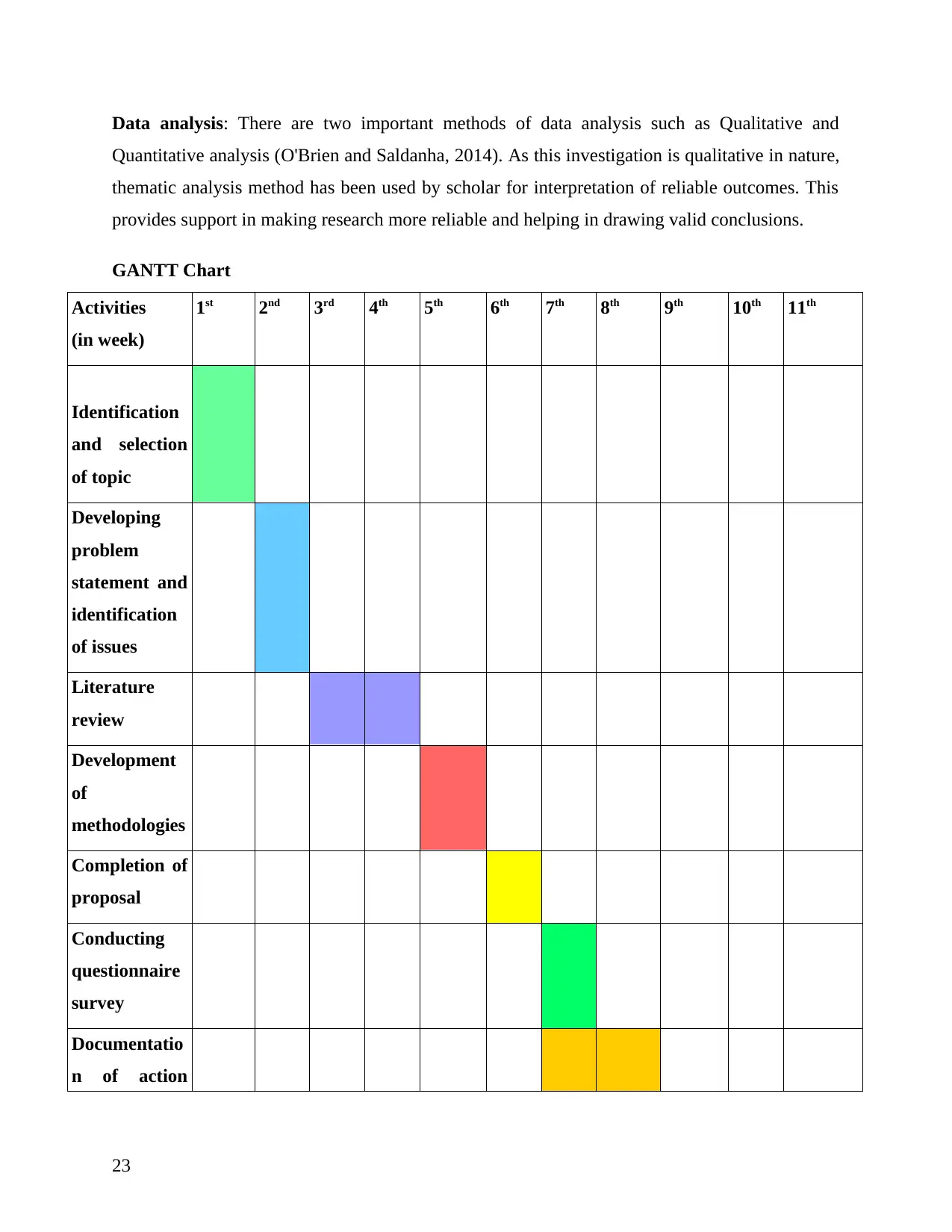
Data analysis: There are two important methods of data analysis such as Qualitative and
Quantitative analysis (O'Brien and Saldanha, 2014). As this investigation is qualitative in nature,
thematic analysis method has been used by scholar for interpretation of reliable outcomes. This
provides support in making research more reliable and helping in drawing valid conclusions.
GANTT Chart
Activities
(in week)
1st 2nd 3rd 4th 5th 6th 7th 8th 9th 10th 11th
Identification
and selection
of topic
Developing
problem
statement and
identification
of issues
Literature
review
Development
of
methodologies
Completion of
proposal
Conducting
questionnaire
survey
Documentatio
n of action
23
Quantitative analysis (O'Brien and Saldanha, 2014). As this investigation is qualitative in nature,
thematic analysis method has been used by scholar for interpretation of reliable outcomes. This
provides support in making research more reliable and helping in drawing valid conclusions.
GANTT Chart
Activities
(in week)
1st 2nd 3rd 4th 5th 6th 7th 8th 9th 10th 11th
Identification
and selection
of topic
Developing
problem
statement and
identification
of issues
Literature
review
Development
of
methodologies
Completion of
proposal
Conducting
questionnaire
survey
Documentatio
n of action
23
Paraphrase This Document
Need a fresh take? Get an instant paraphrase of this document with our AI Paraphraser
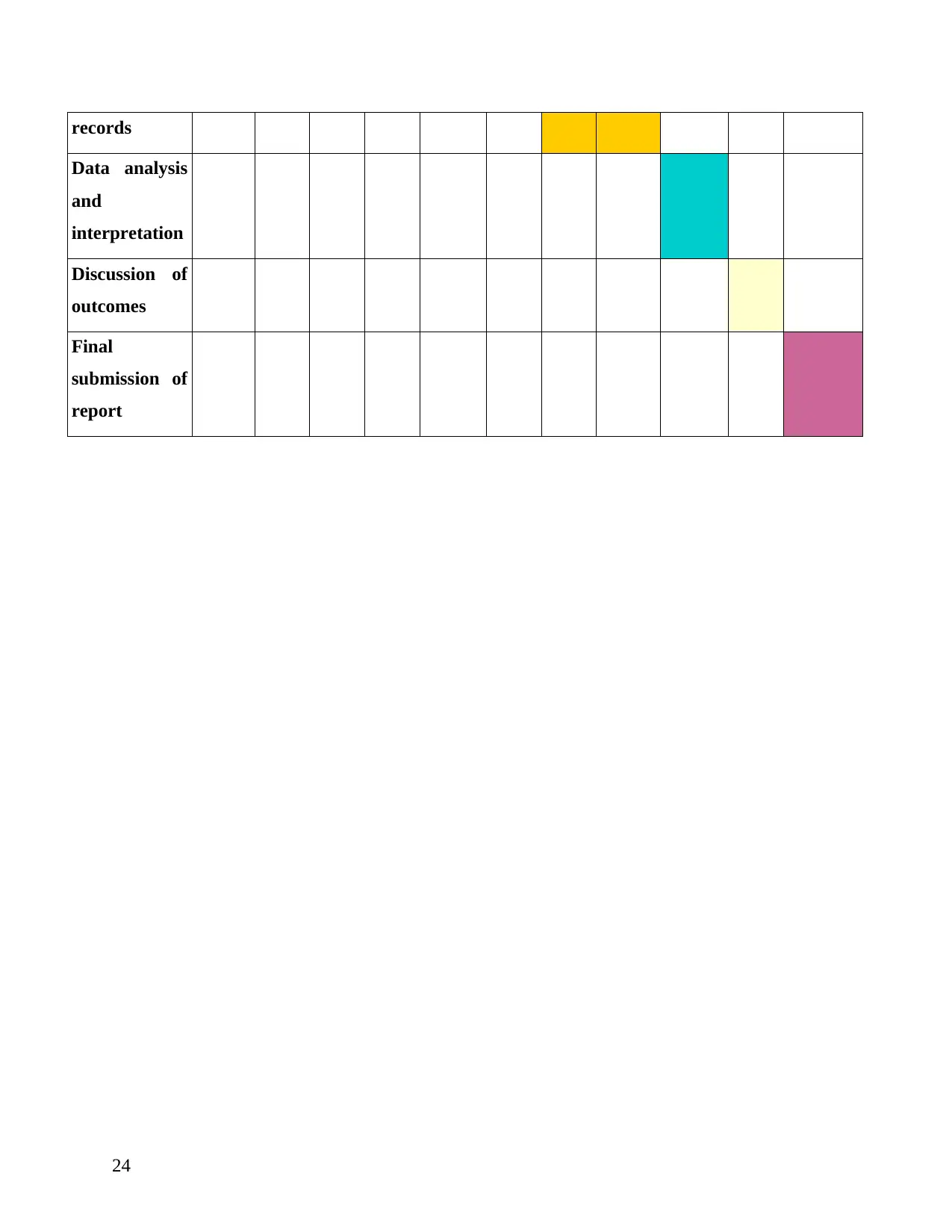
records
Data analysis
and
interpretation
Discussion of
outcomes
Final
submission of
report
24
Data analysis
and
interpretation
Discussion of
outcomes
Final
submission of
report
24

REFERENCES
Books and Journals
Allen, D. and Hughes, D., 2017. Nursing and the Division of Labour in Healthcare. Macmillan
International Higher Education.
Bliss, C.J., 2014. Capital theory and the distribution of income (Vol. 4). Elsevier.
Bonin, J. and Putterman, L., 2013. Economics of cooperation and the labour-managed economy.
Routledge.
Brosnan, M.E. and et.al., 2015. Division of labour: how does folate metabolism partition
between one-carbon metabolism and amino acid oxidation. Biochemical Journal, 472(2),
pp.135-146.
Coleman, R. ed., 2013. Deleuze and research methodologies. Edinburgh University Press.
Dogaru, T. and et.al., 2014. Functional and Sectoral Division of Labour within Central and
Eastern European Countries (No. TI 2014-041/VII).
Edlund, J. and Öun, I., 2016. Who should work and who should care? Attitudes towards the
desirable division of labour between mothers and fathers in five European countries. Acta
Sociologica, 59(2), pp.151-169.
Ferguson-Gow, H. and et.al., 2014. Colony size predicts division of labour in attine ants. Proc.
R. Soc. B, 281(1793), p.20141411.
Gershuny, J., 2018. British cohabitation and the household division of labour (Doctoral
dissertation, University of Oxford).
Guercini, S., 2014. New qualitative research methodologies in management. Management
Decision, 52(4), pp.662-674.
Hale, T. and Held, D. eds., 2018. The handbook of transnational governance: Institutions and
innovations. John Wiley & Sons.
Books and Journals
Allen, D. and Hughes, D., 2017. Nursing and the Division of Labour in Healthcare. Macmillan
International Higher Education.
Bliss, C.J., 2014. Capital theory and the distribution of income (Vol. 4). Elsevier.
Bonin, J. and Putterman, L., 2013. Economics of cooperation and the labour-managed economy.
Routledge.
Brosnan, M.E. and et.al., 2015. Division of labour: how does folate metabolism partition
between one-carbon metabolism and amino acid oxidation. Biochemical Journal, 472(2),
pp.135-146.
Coleman, R. ed., 2013. Deleuze and research methodologies. Edinburgh University Press.
Dogaru, T. and et.al., 2014. Functional and Sectoral Division of Labour within Central and
Eastern European Countries (No. TI 2014-041/VII).
Edlund, J. and Öun, I., 2016. Who should work and who should care? Attitudes towards the
desirable division of labour between mothers and fathers in five European countries. Acta
Sociologica, 59(2), pp.151-169.
Ferguson-Gow, H. and et.al., 2014. Colony size predicts division of labour in attine ants. Proc.
R. Soc. B, 281(1793), p.20141411.
Gershuny, J., 2018. British cohabitation and the household division of labour (Doctoral
dissertation, University of Oxford).
Guercini, S., 2014. New qualitative research methodologies in management. Management
Decision, 52(4), pp.662-674.
Hale, T. and Held, D. eds., 2018. The handbook of transnational governance: Institutions and
innovations. John Wiley & Sons.
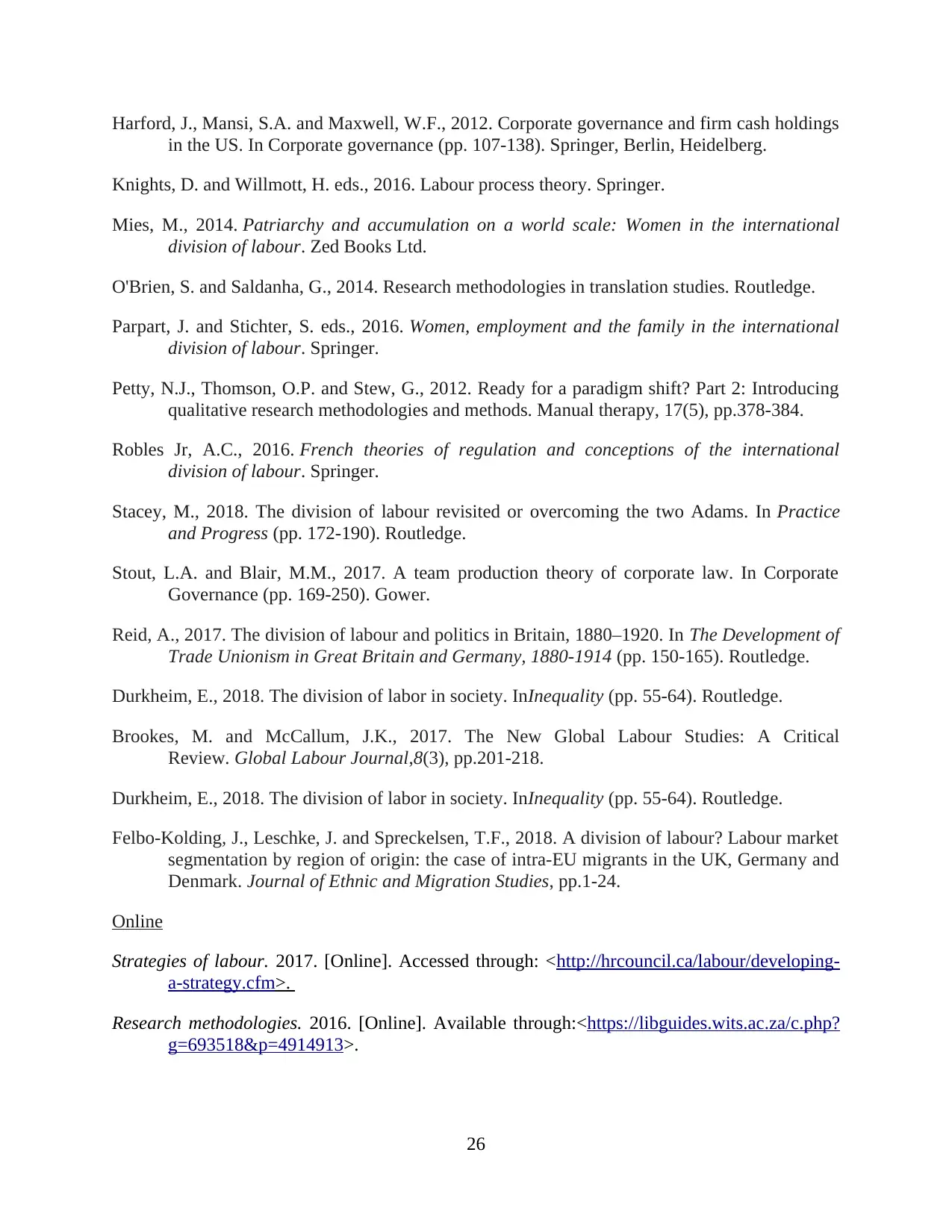
Harford, J., Mansi, S.A. and Maxwell, W.F., 2012. Corporate governance and firm cash holdings
in the US. In Corporate governance (pp. 107-138). Springer, Berlin, Heidelberg.
Knights, D. and Willmott, H. eds., 2016. Labour process theory. Springer.
Mies, M., 2014. Patriarchy and accumulation on a world scale: Women in the international
division of labour. Zed Books Ltd.
O'Brien, S. and Saldanha, G., 2014. Research methodologies in translation studies. Routledge.
Parpart, J. and Stichter, S. eds., 2016. Women, employment and the family in the international
division of labour. Springer.
Petty, N.J., Thomson, O.P. and Stew, G., 2012. Ready for a paradigm shift? Part 2: Introducing
qualitative research methodologies and methods. Manual therapy, 17(5), pp.378-384.
Robles Jr, A.C., 2016. French theories of regulation and conceptions of the international
division of labour. Springer.
Stacey, M., 2018. The division of labour revisited or overcoming the two Adams. In Practice
and Progress (pp. 172-190). Routledge.
Stout, L.A. and Blair, M.M., 2017. A team production theory of corporate law. In Corporate
Governance (pp. 169-250). Gower.
Reid, A., 2017. The division of labour and politics in Britain, 1880–1920. In The Development of
Trade Unionism in Great Britain and Germany, 1880-1914 (pp. 150-165). Routledge.
Durkheim, E., 2018. The division of labor in society. InInequality (pp. 55-64). Routledge.
Brookes, M. and McCallum, J.K., 2017. The New Global Labour Studies: A Critical
Review. Global Labour Journal,8(3), pp.201-218.
Durkheim, E., 2018. The division of labor in society. InInequality (pp. 55-64). Routledge.
Felbo-Kolding, J., Leschke, J. and Spreckelsen, T.F., 2018. A division of labour? Labour market
segmentation by region of origin: the case of intra-EU migrants in the UK, Germany and
Denmark. Journal of Ethnic and Migration Studies, pp.1-24.
Online
Strategies of labour. 2017. [Online]. Accessed through: <http://hrcouncil.ca/labour/developing-
a-strategy.cfm>.
Research methodologies. 2016. [Online]. Available through:<https://libguides.wits.ac.za/c.php?
g=693518&p=4914913>.
26
in the US. In Corporate governance (pp. 107-138). Springer, Berlin, Heidelberg.
Knights, D. and Willmott, H. eds., 2016. Labour process theory. Springer.
Mies, M., 2014. Patriarchy and accumulation on a world scale: Women in the international
division of labour. Zed Books Ltd.
O'Brien, S. and Saldanha, G., 2014. Research methodologies in translation studies. Routledge.
Parpart, J. and Stichter, S. eds., 2016. Women, employment and the family in the international
division of labour. Springer.
Petty, N.J., Thomson, O.P. and Stew, G., 2012. Ready for a paradigm shift? Part 2: Introducing
qualitative research methodologies and methods. Manual therapy, 17(5), pp.378-384.
Robles Jr, A.C., 2016. French theories of regulation and conceptions of the international
division of labour. Springer.
Stacey, M., 2018. The division of labour revisited or overcoming the two Adams. In Practice
and Progress (pp. 172-190). Routledge.
Stout, L.A. and Blair, M.M., 2017. A team production theory of corporate law. In Corporate
Governance (pp. 169-250). Gower.
Reid, A., 2017. The division of labour and politics in Britain, 1880–1920. In The Development of
Trade Unionism in Great Britain and Germany, 1880-1914 (pp. 150-165). Routledge.
Durkheim, E., 2018. The division of labor in society. InInequality (pp. 55-64). Routledge.
Brookes, M. and McCallum, J.K., 2017. The New Global Labour Studies: A Critical
Review. Global Labour Journal,8(3), pp.201-218.
Durkheim, E., 2018. The division of labor in society. InInequality (pp. 55-64). Routledge.
Felbo-Kolding, J., Leschke, J. and Spreckelsen, T.F., 2018. A division of labour? Labour market
segmentation by region of origin: the case of intra-EU migrants in the UK, Germany and
Denmark. Journal of Ethnic and Migration Studies, pp.1-24.
Online
Strategies of labour. 2017. [Online]. Accessed through: <http://hrcouncil.ca/labour/developing-
a-strategy.cfm>.
Research methodologies. 2016. [Online]. Available through:<https://libguides.wits.ac.za/c.php?
g=693518&p=4914913>.
26
Secure Best Marks with AI Grader
Need help grading? Try our AI Grader for instant feedback on your assignments.
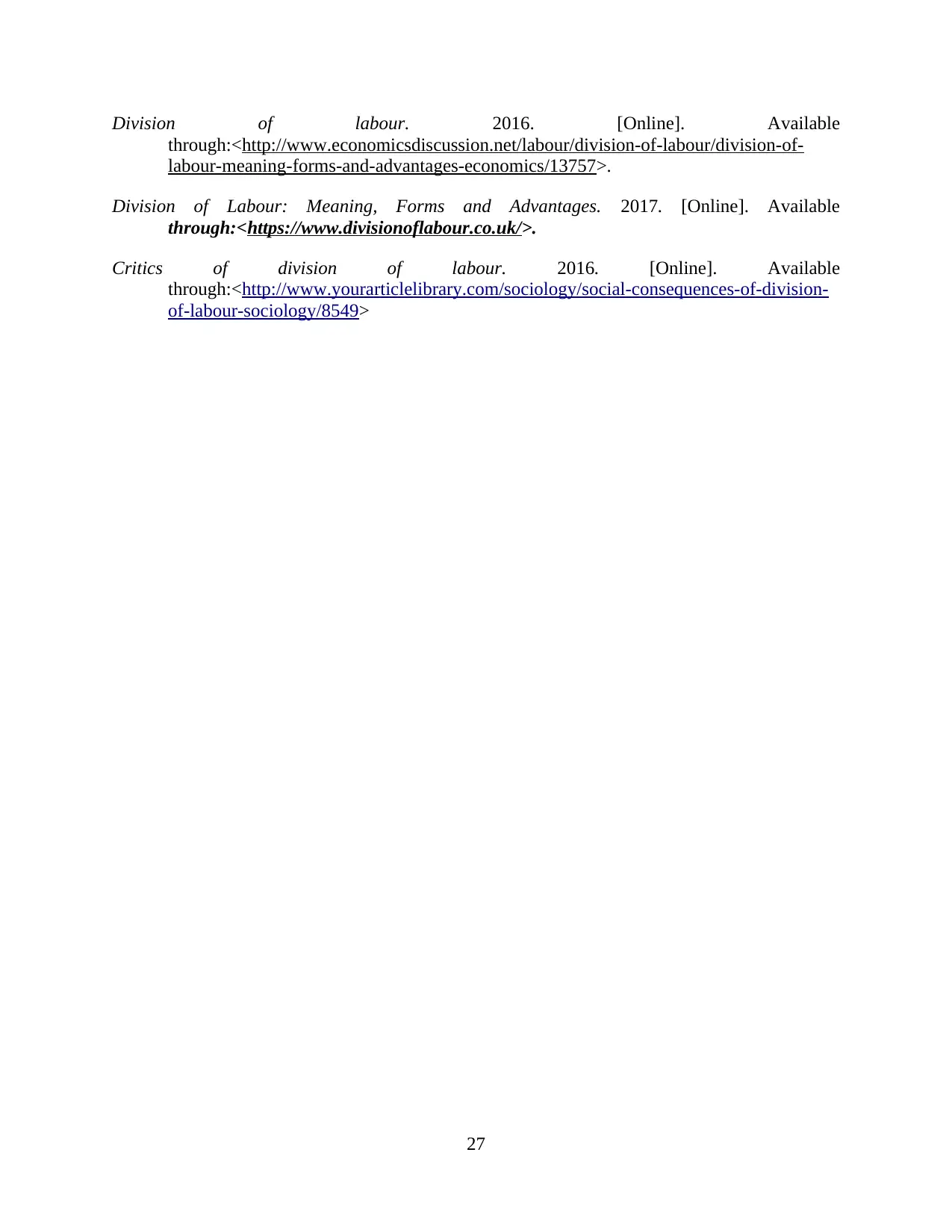
Division of labour. 2016. [Online]. Available
through:<http://www.economicsdiscussion.net/labour/division-of-labour/division-of-
labour-meaning-forms-and-advantages-economics/13757>.
Division of Labour: Meaning, Forms and Advantages. 2017. [Online]. Available
through:<https://www.divisionoflabour.co.uk/>.
Critics of division of labour. 2016. [Online]. Available
through:<http://www.yourarticlelibrary.com/sociology/social-consequences-of-division-
of-labour-sociology/8549>
27
through:<http://www.economicsdiscussion.net/labour/division-of-labour/division-of-
labour-meaning-forms-and-advantages-economics/13757>.
Division of Labour: Meaning, Forms and Advantages. 2017. [Online]. Available
through:<https://www.divisionoflabour.co.uk/>.
Critics of division of labour. 2016. [Online]. Available
through:<http://www.yourarticlelibrary.com/sociology/social-consequences-of-division-
of-labour-sociology/8549>
27

Interview with the Manager1. How do you think employees impact the business?
Answer: The employees have a big impact on the business, where every individual needs to
perform their tasks in such a way to satisfy company’s needs. We have to select tasks
requirements and people to be trained, and must give them support that they need to achieve
performance together.2. What is the management/HR expectation from the employees?
Answer: We expect from our employees to provide supremacy, responsibility, involvement and
quality. We need people who can work in a busy environment as an individual or as a team,
which depends on the tasks that needs to be done. Also, the company provides support and
training to make employees to become confident in their work.3. What is the expectation between new hires and Amazon associates?
Answer: As an organisation to resist in the market, we need to work hard to have skilled and
positive people in our team. The company needs people to perform well under the pressure
(when it requests) to be capable to manage their tasks in such a way that does not affect the
customers’ needs and trust. Especially when we have to achieve CPT (Critically Pull Time)
together; we have to do our best so at the end of the day, one must be proud of performance. As
an organisation, customers’ satisfaction is our goal, providing seriousness, quality and trust for
the future.4. Which do you think should be the employees’ objective?
Answer: The company’s policy is to bring new hires at the same level with our associates to
perform well from the beginning, to make them to be involved and to see them as a potential
associate by providing full training and support. Also, in their first week, the associates have to
achieve 75% target through which they can prove their capability and involvement. On the
other hand, after a week or even two, they would be aware with the following period of time.
28
Answer: The employees have a big impact on the business, where every individual needs to
perform their tasks in such a way to satisfy company’s needs. We have to select tasks
requirements and people to be trained, and must give them support that they need to achieve
performance together.2. What is the management/HR expectation from the employees?
Answer: We expect from our employees to provide supremacy, responsibility, involvement and
quality. We need people who can work in a busy environment as an individual or as a team,
which depends on the tasks that needs to be done. Also, the company provides support and
training to make employees to become confident in their work.3. What is the expectation between new hires and Amazon associates?
Answer: As an organisation to resist in the market, we need to work hard to have skilled and
positive people in our team. The company needs people to perform well under the pressure
(when it requests) to be capable to manage their tasks in such a way that does not affect the
customers’ needs and trust. Especially when we have to achieve CPT (Critically Pull Time)
together; we have to do our best so at the end of the day, one must be proud of performance. As
an organisation, customers’ satisfaction is our goal, providing seriousness, quality and trust for
the future.4. Which do you think should be the employees’ objective?
Answer: The company’s policy is to bring new hires at the same level with our associates to
perform well from the beginning, to make them to be involved and to see them as a potential
associate by providing full training and support. Also, in their first week, the associates have to
achieve 75% target through which they can prove their capability and involvement. On the
other hand, after a week or even two, they would be aware with the following period of time.
28
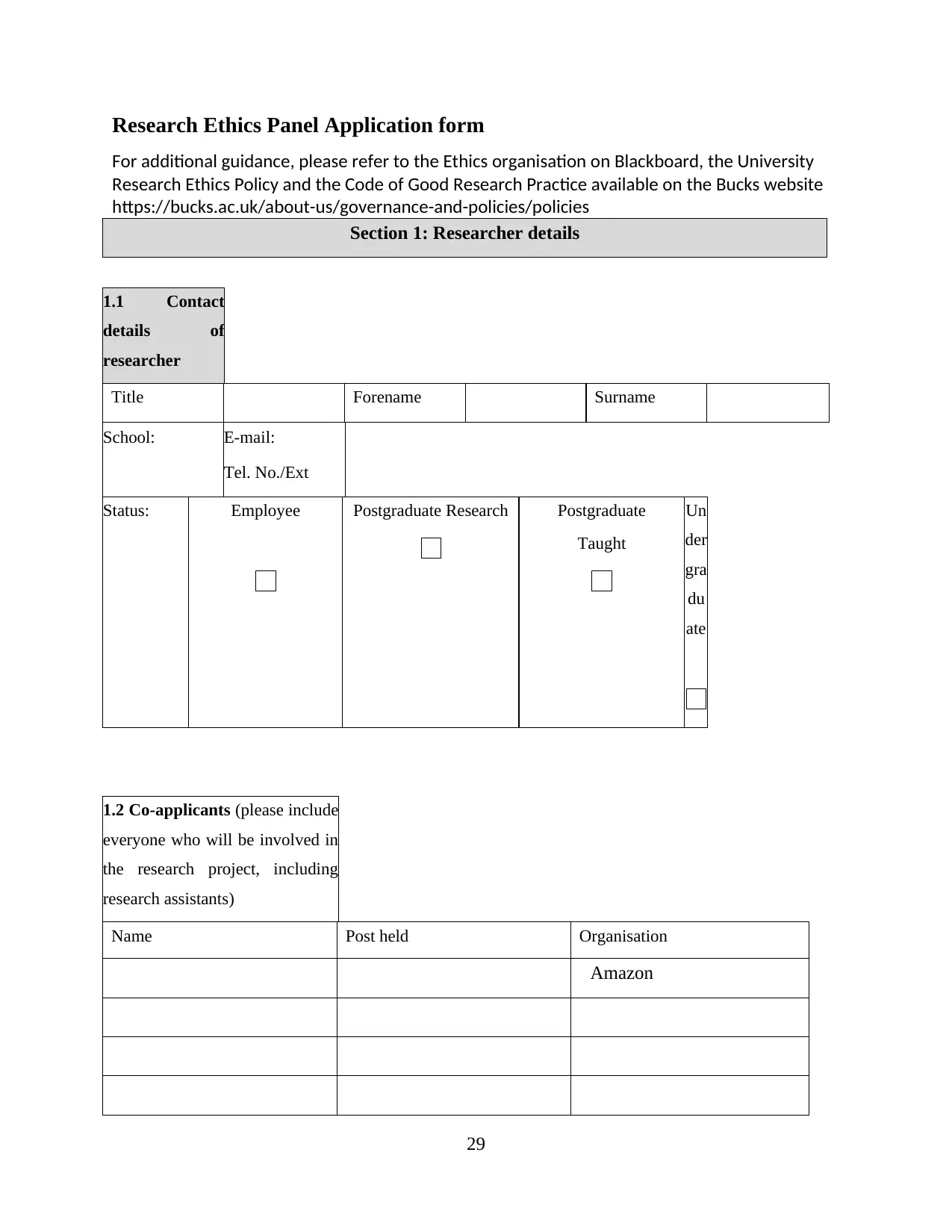
Research Ethics Panel Application form
For additional guidance, please refer to the Ethics organisation on Blackboard, the University
Research Ethics Policy and the Code of Good Research Practice available on the Bucks website
https://bucks.ac.uk/about-us/governance-and-policies/policies
Section 1: Researcher details
1.1 Contact
details of
researcher
Title Forename Surname
School: E-mail:
Tel. No./Ext
Status: Employee Postgraduate Research Postgraduate
Taught
Un
der
gra
du
ate
1.2 Co-applicants (please include
everyone who will be involved in
the research project, including
research assistants)
Name Post held Organisation
Amazon
29
For additional guidance, please refer to the Ethics organisation on Blackboard, the University
Research Ethics Policy and the Code of Good Research Practice available on the Bucks website
https://bucks.ac.uk/about-us/governance-and-policies/policies
Section 1: Researcher details
1.1 Contact
details of
researcher
Title Forename Surname
School: E-mail:
Tel. No./Ext
Status: Employee Postgraduate Research Postgraduate
Taught
Un
der
gra
du
ate
1.2 Co-applicants (please include
everyone who will be involved in
the research project, including
research assistants)
Name Post held Organisation
Amazon
29
Paraphrase This Document
Need a fresh take? Get an instant paraphrase of this document with our AI Paraphraser

Section 2: Project details
2.1 Project title and timescale
Ethical approval is only valid for the time period
specified on your application. Extension of period
will require further approval.
Title DISTRIBUTION OF LABOUR IN AMAZON WAREHOUSE
Proposed start date:
Proposed end date: (of
data collection)
2.2 Costs and funding
$200
2.3 Brief project description
The project was based on corporate governance and strategy such as Distribution of labours
and its impact on businesses. Researcher has conducted an interview with a manager in
warehouse. Secondary sources like Books, academic journal, articles and company’s
website or online blogs will be used to collect alternative information in this research. The
employees of the company were selected for he interview. The research identified that
30
2.1 Project title and timescale
Ethical approval is only valid for the time period
specified on your application. Extension of period
will require further approval.
Title DISTRIBUTION OF LABOUR IN AMAZON WAREHOUSE
Proposed start date:
Proposed end date: (of
data collection)
2.2 Costs and funding
$200
2.3 Brief project description
The project was based on corporate governance and strategy such as Distribution of labours
and its impact on businesses. Researcher has conducted an interview with a manager in
warehouse. Secondary sources like Books, academic journal, articles and company’s
website or online blogs will be used to collect alternative information in this research. The
employees of the company were selected for he interview. The research identified that
30
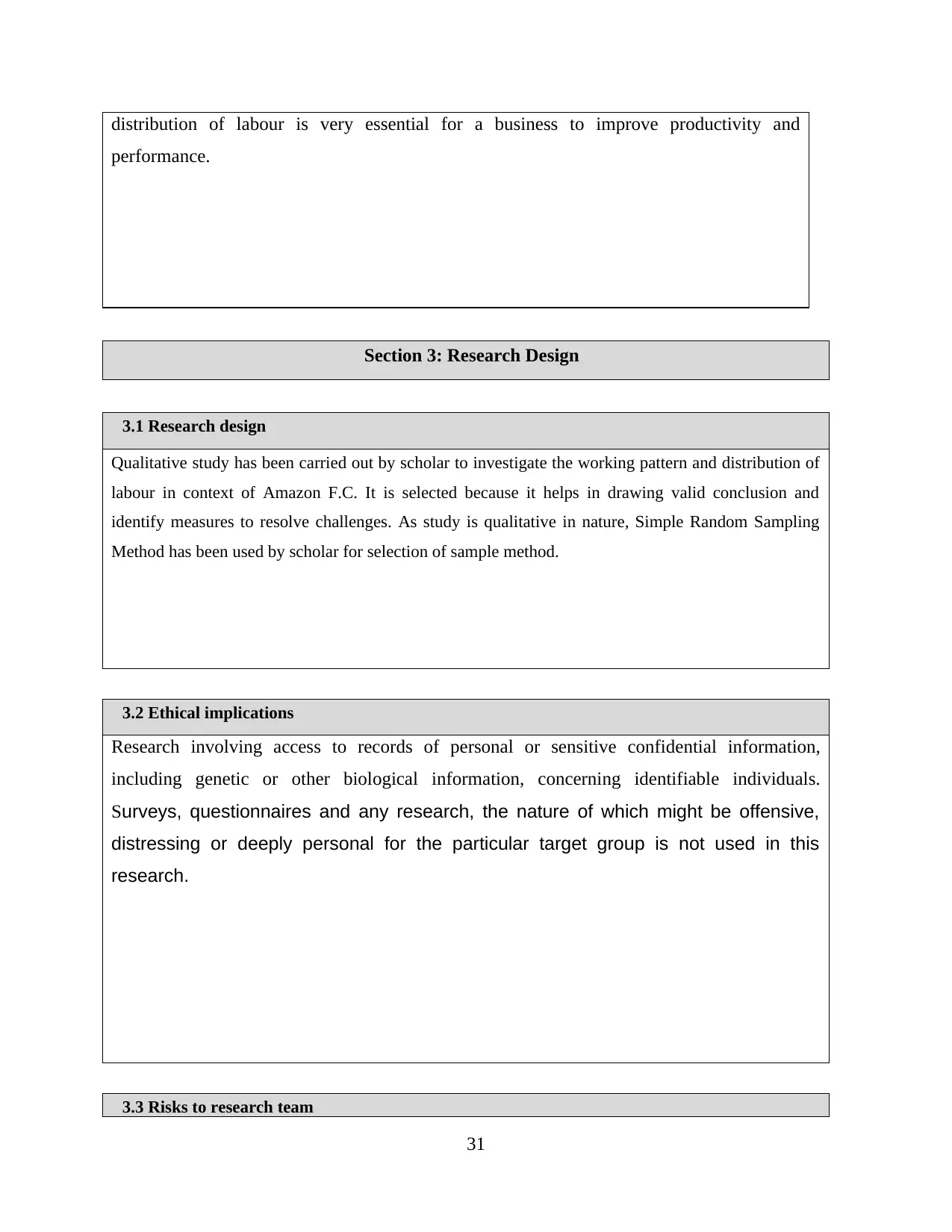
distribution of labour is very essential for a business to improve productivity and
performance.
Section 3: Research Design
3.1 Research design
Qualitative study has been carried out by scholar to investigate the working pattern and distribution of
labour in context of Amazon F.C. It is selected because it helps in drawing valid conclusion and
identify measures to resolve challenges. As study is qualitative in nature, Simple Random Sampling
Method has been used by scholar for selection of sample method.
3.2 Ethical implications
Research involving access to records of personal or sensitive confidential information,
including genetic or other biological information, concerning identifiable individuals.
Surveys, questionnaires and any research, the nature of which might be offensive,
distressing or deeply personal for the particular target group is not used in this
research.
3.3 Risks to research team
31
performance.
Section 3: Research Design
3.1 Research design
Qualitative study has been carried out by scholar to investigate the working pattern and distribution of
labour in context of Amazon F.C. It is selected because it helps in drawing valid conclusion and
identify measures to resolve challenges. As study is qualitative in nature, Simple Random Sampling
Method has been used by scholar for selection of sample method.
3.2 Ethical implications
Research involving access to records of personal or sensitive confidential information,
including genetic or other biological information, concerning identifiable individuals.
Surveys, questionnaires and any research, the nature of which might be offensive,
distressing or deeply personal for the particular target group is not used in this
research.
3.3 Risks to research team
31
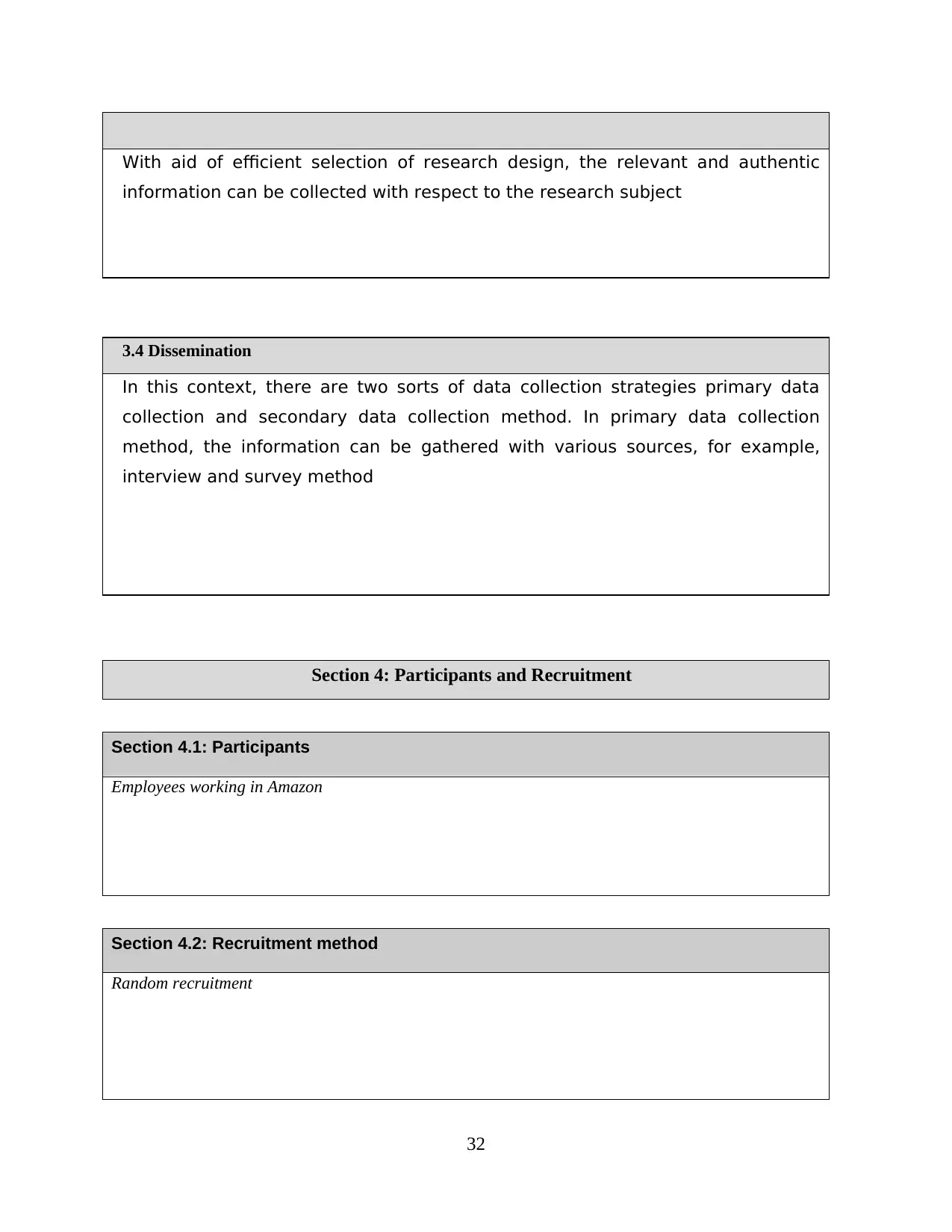
With aid of efficient selection of research design, the relevant and authentic
information can be collected with respect to the research subject
3.4 Dissemination
In this context, there are two sorts of data collection strategies primary data
collection and secondary data collection method. In primary data collection
method, the information can be gathered with various sources, for example,
interview and survey method
Section 4: Participants and Recruitment
Section 4.1: Participants
Employees working in Amazon
Section 4.2: Recruitment method
Random recruitment
32
information can be collected with respect to the research subject
3.4 Dissemination
In this context, there are two sorts of data collection strategies primary data
collection and secondary data collection method. In primary data collection
method, the information can be gathered with various sources, for example,
interview and survey method
Section 4: Participants and Recruitment
Section 4.1: Participants
Employees working in Amazon
Section 4.2: Recruitment method
Random recruitment
32
Secure Best Marks with AI Grader
Need help grading? Try our AI Grader for instant feedback on your assignments.
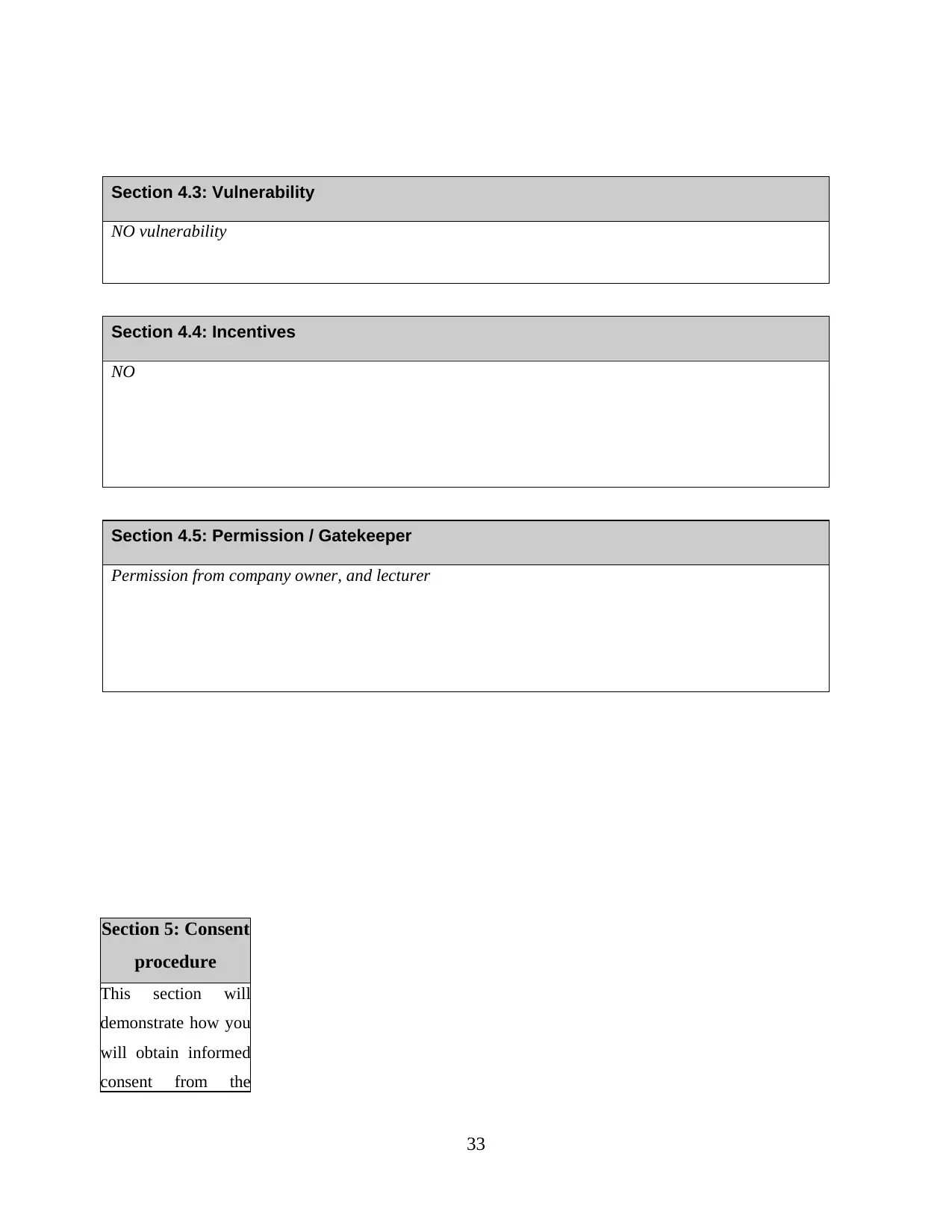
Section 4.3: Vulnerability
NO vulnerability
Section 4.4: Incentives
NO
Section 4.5: Permission / Gatekeeper
Permission from company owner, and lecturer
Section 5: Consent
procedure
This section will
demonstrate how you
will obtain informed
consent from the
33
NO vulnerability
Section 4.4: Incentives
NO
Section 4.5: Permission / Gatekeeper
Permission from company owner, and lecturer
Section 5: Consent
procedure
This section will
demonstrate how you
will obtain informed
consent from the
33
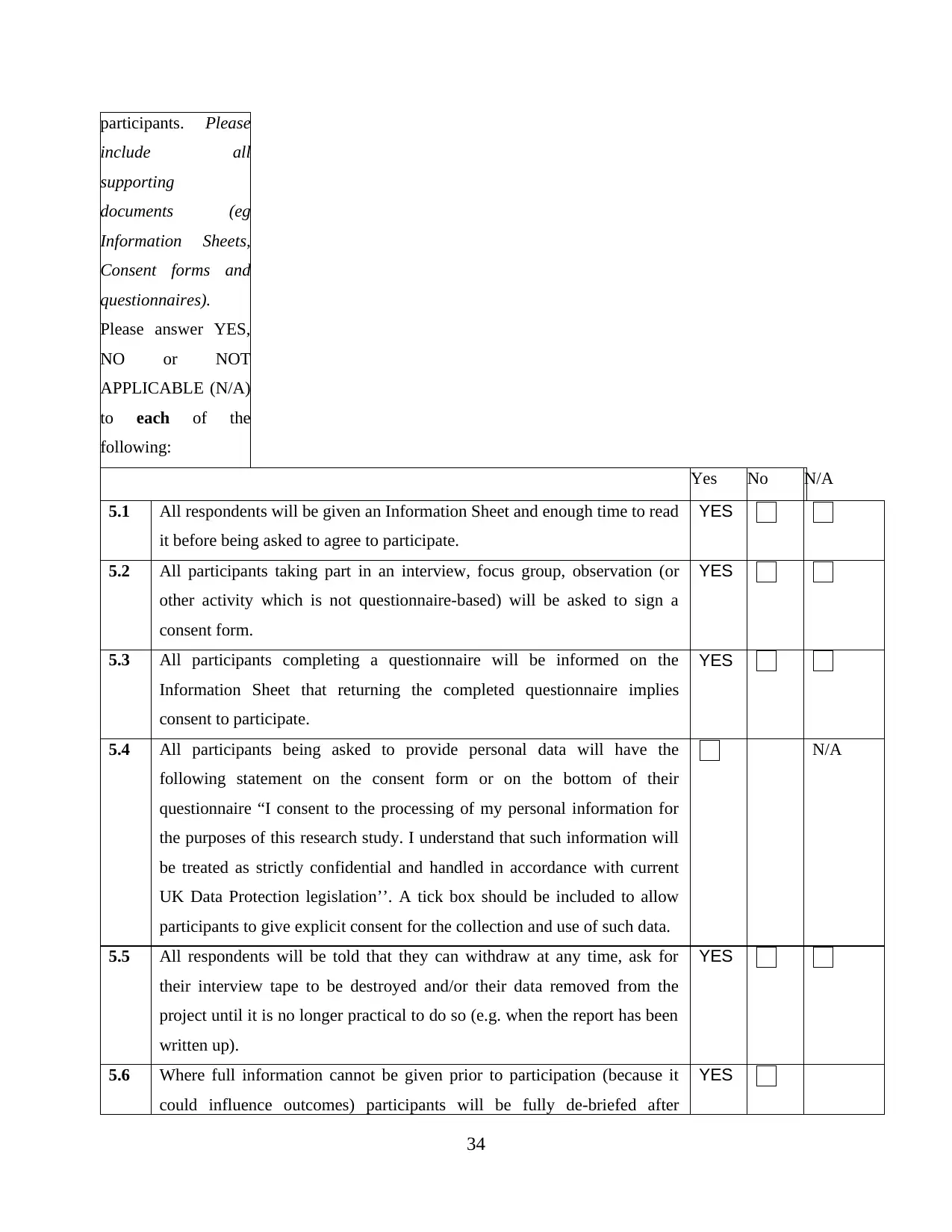
participants. Please
include all
supporting
documents (eg
Information Sheets,
Consent forms and
questionnaires).
Please answer YES,
NO or NOT
APPLICABLE (N/A)
to each of the
following:
Yes No N/A
5.1 All respondents will be given an Information Sheet and enough time to read
it before being asked to agree to participate.
YES
5.2 All participants taking part in an interview, focus group, observation (or
other activity which is not questionnaire-based) will be asked to sign a
consent form.
YES
5.3 All participants completing a questionnaire will be informed on the
Information Sheet that returning the completed questionnaire implies
consent to participate.
YES
5.4 All participants being asked to provide personal data will have the
following statement on the consent form or on the bottom of their
questionnaire “I consent to the processing of my personal information for
the purposes of this research study. I understand that such information will
be treated as strictly confidential and handled in accordance with current
UK Data Protection legislation’’. A tick box should be included to allow
participants to give explicit consent for the collection and use of such data.
N/A
5.5 All respondents will be told that they can withdraw at any time, ask for
their interview tape to be destroyed and/or their data removed from the
project until it is no longer practical to do so (e.g. when the report has been
written up).
YES
5.6 Where full information cannot be given prior to participation (because it
could influence outcomes) participants will be fully de-briefed after
YES
34
include all
supporting
documents (eg
Information Sheets,
Consent forms and
questionnaires).
Please answer YES,
NO or NOT
APPLICABLE (N/A)
to each of the
following:
Yes No N/A
5.1 All respondents will be given an Information Sheet and enough time to read
it before being asked to agree to participate.
YES
5.2 All participants taking part in an interview, focus group, observation (or
other activity which is not questionnaire-based) will be asked to sign a
consent form.
YES
5.3 All participants completing a questionnaire will be informed on the
Information Sheet that returning the completed questionnaire implies
consent to participate.
YES
5.4 All participants being asked to provide personal data will have the
following statement on the consent form or on the bottom of their
questionnaire “I consent to the processing of my personal information for
the purposes of this research study. I understand that such information will
be treated as strictly confidential and handled in accordance with current
UK Data Protection legislation’’. A tick box should be included to allow
participants to give explicit consent for the collection and use of such data.
N/A
5.5 All respondents will be told that they can withdraw at any time, ask for
their interview tape to be destroyed and/or their data removed from the
project until it is no longer practical to do so (e.g. when the report has been
written up).
YES
5.6 Where full information cannot be given prior to participation (because it
could influence outcomes) participants will be fully de-briefed after
YES
34
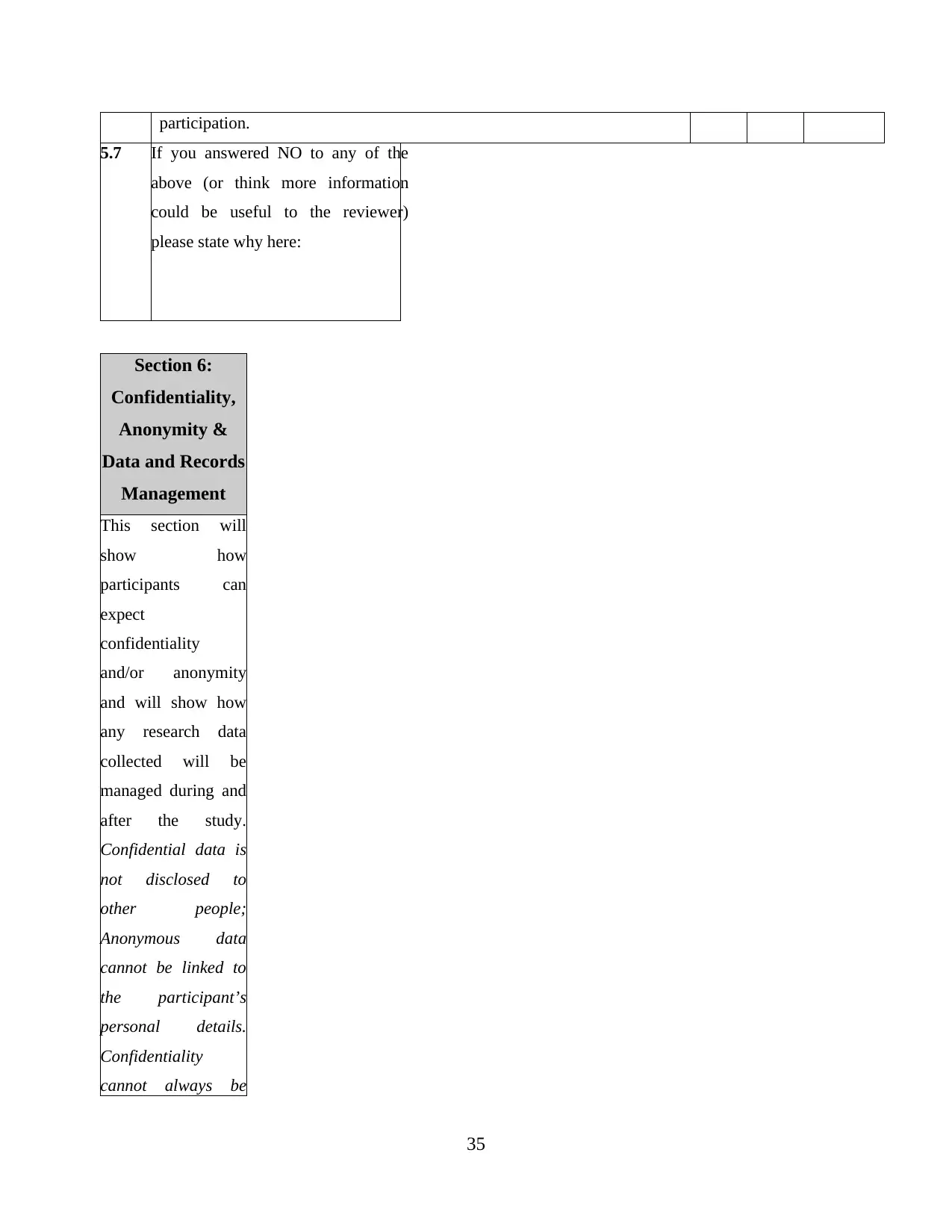
participation.
5.7 If you answered NO to any of the
above (or think more information
could be useful to the reviewer)
please state why here:
Section 6:
Confidentiality,
Anonymity &
Data and Records
Management
This section will
show how
participants can
expect
confidentiality
and/or anonymity
and will show how
any research data
collected will be
managed during and
after the study.
Confidential data is
not disclosed to
other people;
Anonymous data
cannot be linked to
the participant’s
personal details.
Confidentiality
cannot always be
35
5.7 If you answered NO to any of the
above (or think more information
could be useful to the reviewer)
please state why here:
Section 6:
Confidentiality,
Anonymity &
Data and Records
Management
This section will
show how
participants can
expect
confidentiality
and/or anonymity
and will show how
any research data
collected will be
managed during and
after the study.
Confidential data is
not disclosed to
other people;
Anonymous data
cannot be linked to
the participant’s
personal details.
Confidentiality
cannot always be
35
Paraphrase This Document
Need a fresh take? Get an instant paraphrase of this document with our AI Paraphraser
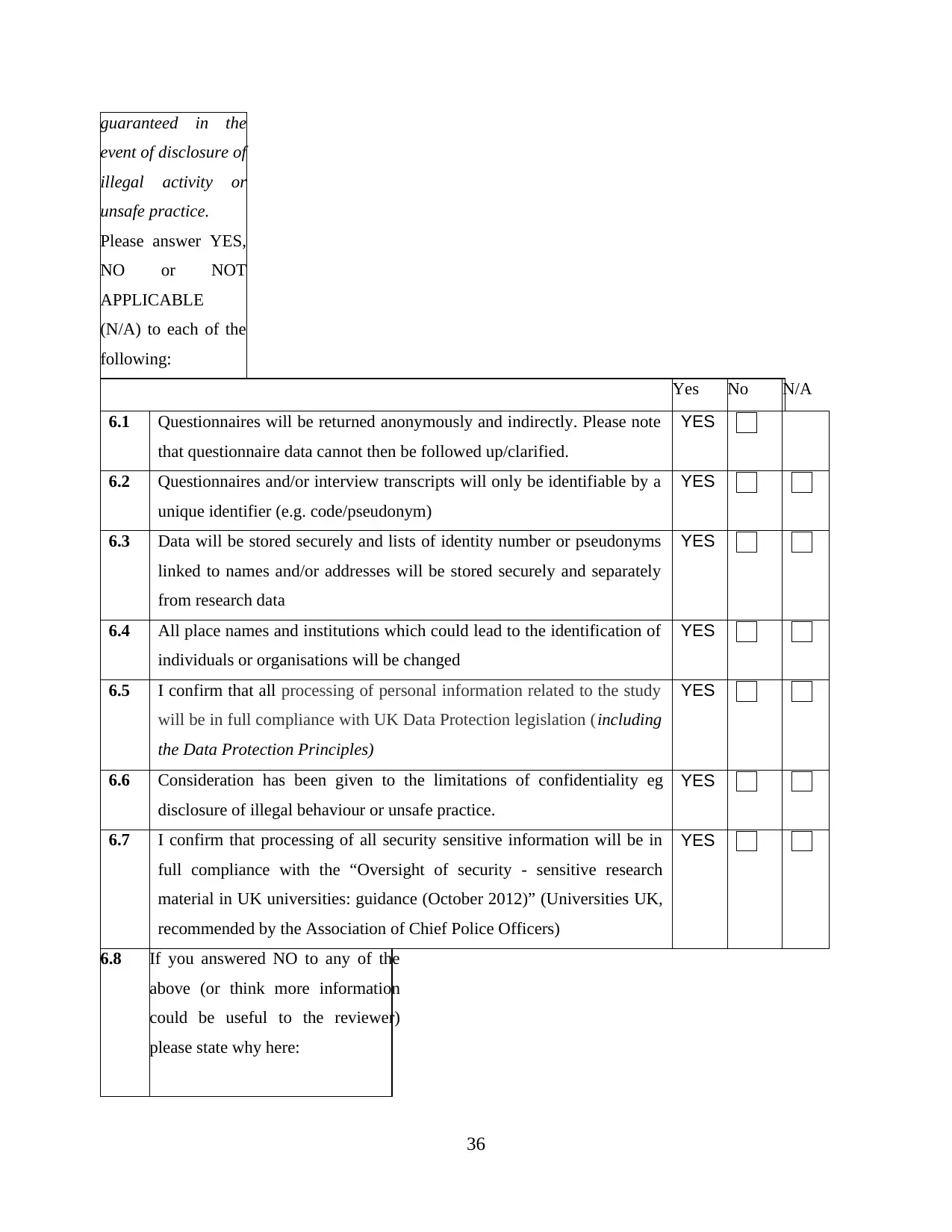
guaranteed in the
event of disclosure of
illegal activity or
unsafe practice.
Please answer YES,
NO or NOT
APPLICABLE
(N/A) to each of the
following:
Yes No N/A
6.1 Questionnaires will be returned anonymously and indirectly. Please note
that questionnaire data cannot then be followed up/clarified.
YES
6.2 Questionnaires and/or interview transcripts will only be identifiable by a
unique identifier (e.g. code/pseudonym)
YES
6.3 Data will be stored securely and lists of identity number or pseudonyms
linked to names and/or addresses will be stored securely and separately
from research data
YES
6.4 All place names and institutions which could lead to the identification of
individuals or organisations will be changed
YES
6.5 I confirm that all processing of personal information related to the study
will be in full compliance with UK Data Protection legislation (including
the Data Protection Principles)
YES
6.6 Consideration has been given to the limitations of confidentiality eg
disclosure of illegal behaviour or unsafe practice.
YES
6.7 I confirm that processing of all security sensitive information will be in
full compliance with the “Oversight of security - sensitive research
material in UK universities: guidance (October 2012)” (Universities UK,
recommended by the Association of Chief Police Officers)
YES
6.8 If you answered NO to any of the
above (or think more information
could be useful to the reviewer)
please state why here:
36
event of disclosure of
illegal activity or
unsafe practice.
Please answer YES,
NO or NOT
APPLICABLE
(N/A) to each of the
following:
Yes No N/A
6.1 Questionnaires will be returned anonymously and indirectly. Please note
that questionnaire data cannot then be followed up/clarified.
YES
6.2 Questionnaires and/or interview transcripts will only be identifiable by a
unique identifier (e.g. code/pseudonym)
YES
6.3 Data will be stored securely and lists of identity number or pseudonyms
linked to names and/or addresses will be stored securely and separately
from research data
YES
6.4 All place names and institutions which could lead to the identification of
individuals or organisations will be changed
YES
6.5 I confirm that all processing of personal information related to the study
will be in full compliance with UK Data Protection legislation (including
the Data Protection Principles)
YES
6.6 Consideration has been given to the limitations of confidentiality eg
disclosure of illegal behaviour or unsafe practice.
YES
6.7 I confirm that processing of all security sensitive information will be in
full compliance with the “Oversight of security - sensitive research
material in UK universities: guidance (October 2012)” (Universities UK,
recommended by the Association of Chief Police Officers)
YES
6.8 If you answered NO to any of the
above (or think more information
could be useful to the reviewer)
please state why here:
36
1 out of 38
Related Documents
Your All-in-One AI-Powered Toolkit for Academic Success.
+13062052269
info@desklib.com
Available 24*7 on WhatsApp / Email
![[object Object]](/_next/static/media/star-bottom.7253800d.svg)
Unlock your academic potential
© 2024 | Zucol Services PVT LTD | All rights reserved.





